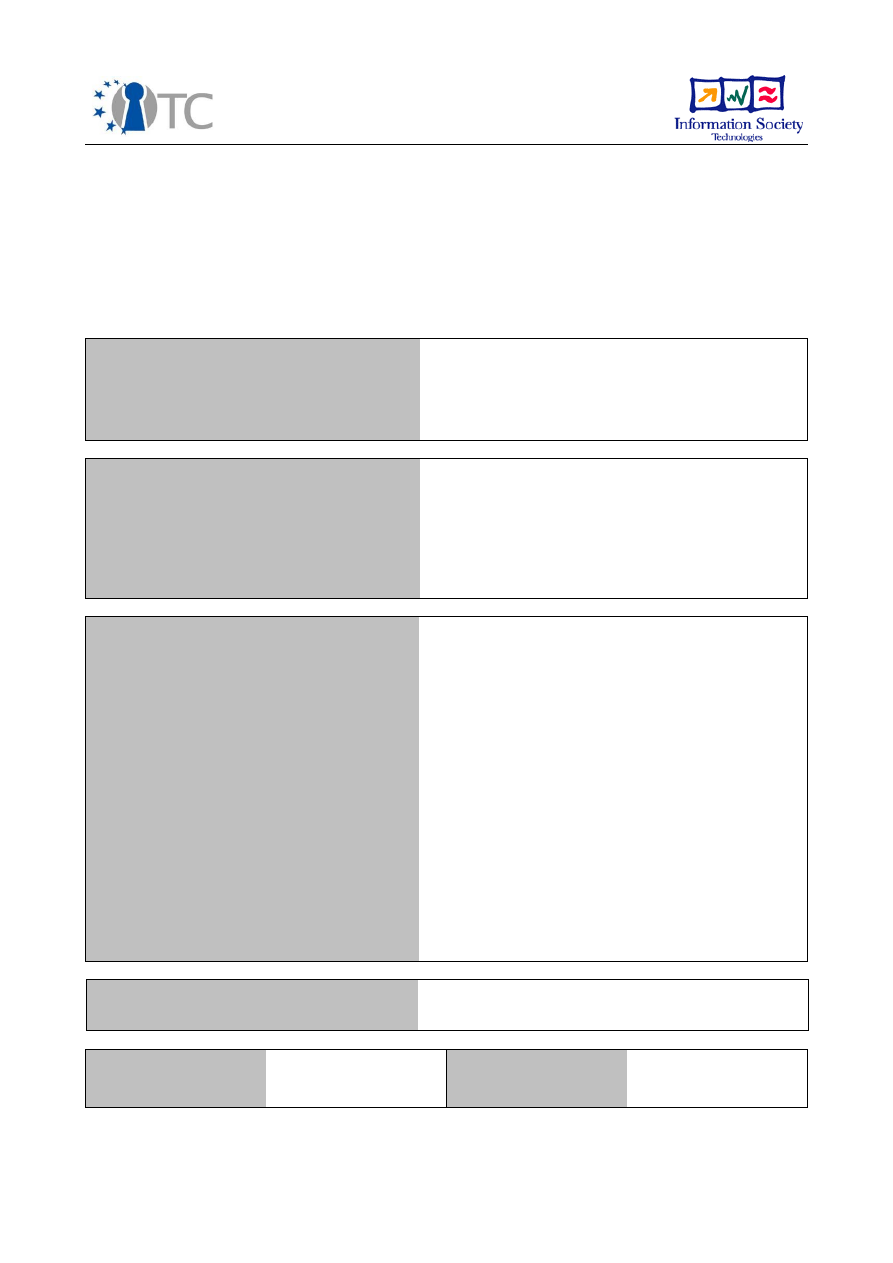
D6.1: Collection of all SWP deliverables
(with nature=R) produced during months 1-12
Project number
IST-027635
Project acronym
Open_TC
Project title
Open Trusted Computing
Deliverable type
Main Deliverable
Deliverable reference number
IST-027635/D6.1/PUBLIC | 1.10
Deliverable title
Collection of all SWP deliverables (with
nature=R) produced during months 1-12
WP contributing to the deliverable
WP6
Due date
Apr 2007
Actual submission date
Apr 2007
Responsible Organisation
POL
Authors
See the cover page of each included internal
deliverable
Abstract
Collection of all internal deliverables (with
nature=R) produced during months 1-12:
D06a.1: Preliminary DRM system
specification
D06e.1: MFA Requirements and Specification
D06e.3: Intermediate MFA System
Specification
NOTE: a general explanation section has
been added and sections 1, 3.6.1,
3.6.2 of D06a.1 have been updated
Keywords
Dissemination level
Public
Revision
PUBLIC | 1.10
Instrument
IP
Start date of the
project
1
st
November 2005
Thematic Priority
IST
Duration
42 months

1 Introduction
This section has been added on request from the EC reviewers. Its purpose is to clarify
the relationships between Workpackage 2 and Workpackage 6, namely how the
requirements set in the former have impact on the latter. In particular this section
explains which elements from Trusted Computing (TC) technology are used in WP6 to
meet the requirements specified in WP2.
2 Workpackage 6's context and purpose
WP6 is related to applications that make use of Trusted Computing and virtualisation
technologies to reach security goals difficult to achieve using other technologies or
obtainable at a higher price. The foundations of such technologies are hardware and
software components: (1) the Trusted Platform Module (TPM) which is a low cost chip
shipped with most of recent platforms together with the (2) new generation of Intel
and AMD processors and chipsets that provide hardware assistance for virtualisation
and hardware support for the platform integrity protection and measurement and (3)
open source Virtual Machine Monitors (VMM) like Xen and Fiasco, an implementation
of L4 micro-kernel family.
Since the core workpackages (WP3 to WP5) are in charge to design and develop a
security framework (OpenTC) based on the mentioned technologies, WP6's purpose is
to show which security benefits can be achieved using such framework in different
application areas.
Moreover two of five WP6 applications are special cases: Encryption File Service (EFS,
in Sub-workpackage 6.d) and MultiFactor Authentication (MFA, Sub-workpackage 6.e)
are applications that show the use of the technology but they can be also considered
as components to be shipped with the framework.
3 Use of TC technology in Sub-workpackages 6.a and 6.e
3.1 SWP06.a: Interoperable DRM solution based on MPEG-21
This subsection applies to the following internal deliverable:
–
D06a.1 Preliminary DRM system specification (included in main deliverable D6.1)
The objective of this Sub-workpackage is to design and develop a DRM system capable
to balance the rights and obligations of all involved stakeholders (i.e. the end user and
the content provider) to support a more fair use of DRM. Some relevant requirements
for the stakeholders are:
–
(content provider) guarantee that the user's system will play the multimedia
content only in accordance with the terms of the license
–
(user) support for user rights for playing the content on different devices, sharing
the content among a limited number of close users and re-selling the content
–
(user) user is in control of his platform: no hidden software needs to be installed by
the content provider to protect the content from unauthorized uses

One key element to meet these requirements is the support for interoperable (i.e.
standard) formats for both encrypted contents and licenses. Instead, the technological
elements provided by OpenTC framework to satisfy the mentioned requirements are:
–
open design and open source system: this allows the inspection by the users'
community to verify that hidden components are not present (see for example the
case of like the Sony rootkit)
–
TPM on the user platform for collecting the integrity measurements of the platform
and software components; these measurements will be used for
–
remote attestation performed by the content provider to check the integrity
of the user's platform before sending the decryption keys
–
secure storage for keys and other relevant data which are bound to a good
status of the user's platform (sealing), represented by specific sets of
measurements
–
isolation provided by virtualisation for separating the DRM code and the player into
protected containers, to guarantee that license parsing and content decryption are
performed separately in secure environments
–
cryptographic services and support for PKI
For further details about the technical requirements from other workpackages, namely
properties and services provided by OpenTC framework to this application, see main
deliverable D02.2 (the updated version of D02.1), section 11.2.1.
3.2 SWP06.e: MultiFactor Authentication (MFA)
This subsection applies to the following internal deliverables:
–
D06e.1 MFA Requirements and Specification (included in main deliverable D6.1)
–
D06e.2 MFA Intermediate Specification (included in main deliverable D6.1)
–
D06e.3 MFA Concept Prototype (included in main deliverable D6.2)
The objective of this Sub-workpackage is to design and develop a MultiFactor
Authentication (MFA) system for client-server applications, namely a system that
provides an additional factor for making the authentication stronger when accessing a
service through a network.
This is an application of TC technology but not an end-user one: it is instead a
subsystem that can be integrated in other systems or frameworks like OpenTC to
enhance the robustness of the authentication.
For instance, the usual password-based authentication scheme for a user, cannot be
considered robust, even though performed through a robust protocol. In fact the
passwords can be stoled through a social engineering attack no matter which is the
robustness of the authentication system. MFA can be used to increase the
The requirements for the parties involved in a networked interaction (client and
server) for having a more robust authentication mechanism are
–
the use of an additional factor based on the TPM to implement the platform
authentication;
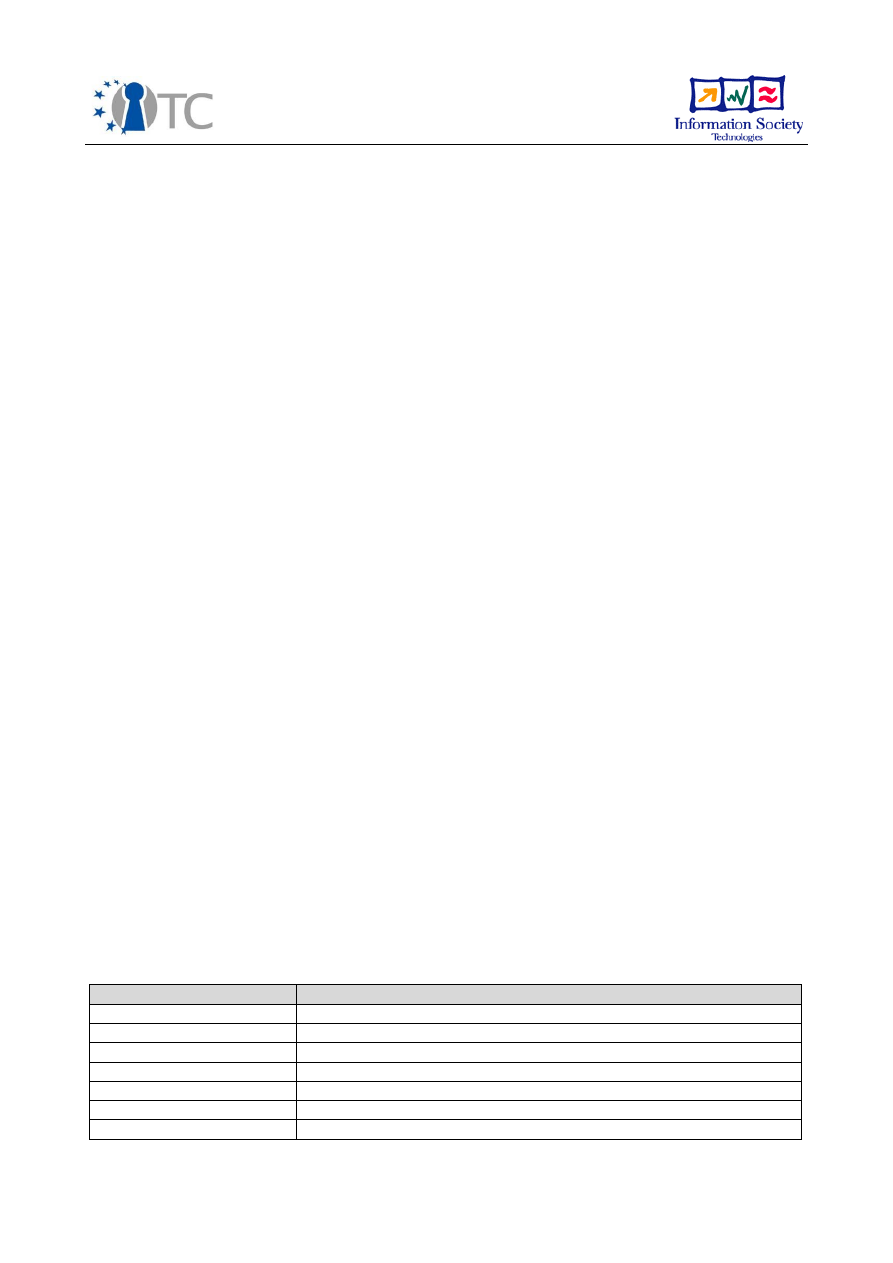
–
only users from registered client platforms can access a service
–
the user can can verify the identity integrity of the platform providing the
service
–
seamless integration into existing systems and authentication subsystems
MFA is designed to be a general purpose subsystem that can be used with a variety
systems. However there are specific uses for OpenTC. Given the the high level of
assurance that OpenTC should provide, MFA can be used as component of OpenTC
framework for allowing its remote management only from a registered workstations.
However it can also be used completely contained within an OpenTC framework
running on single physical platform for accessing network services provided by some
Virtual Machines to other Virtual Machines.
The technological elements provided by OpenTC framework to satisfy such
requirements are:
–
TPM on the client for performing the signature over a random challenge with a
protected key to authenticate the user's platform
–
TPM on the server for locally encrypting the MFA policy database and bind it to a
good status of the platform (sealing)
–
isolation provided by virtualisation for separating the security critical service for
remote management service - for instance sshd for management from a remote
console - which is security critical from the other applications and services
For further details about the MFA see D02.2 (the updated version of D02.1), section
11.6.
The Concept Prototype (see internal deliverable D6e.2) is an example to experiment
and show that is possible to add a further authentication based on the TPM to an
existing network applications (like ssh/sshd) and authentication framework (like Linux
PAM). Therefore only part of the planned features/capabilities have been included in
this preliminary prototype: for instance the mutual authentication has not been
implemented.
The final prototype, instead will be a featured component that will provide an API for
remote access to the service; the preliminary specification of such API has been as
“MFA intermediate specifications” (see internal deliverable D6e.3).
4 List of abbreviations
Listing of term definitions and abbreviations used in the overview documents and
architectural design specification (IT expressions and terms from the application
domain).
Abbreviation
Explanation
API
Application Programming Interface
DRM
Digital Right Management
MFA
MultiFactor Authentication
PKI
Public Key Infrastructure
WP
Workpackage
SWP
Sub-Workpackage
TC
Trusted Computing

5 Referenced Documents
/1/ PAM
http://www.kernel.org/pub/linux/libs/pam/Linux-PAM-html/Linux-
PAM_ADG.html
http://msdn.microsoft.com
Version 0.99.6.0, 5. August 2006.
/2/ OpenTC: D02.2 Requirements Definition and Specification (April 2007)
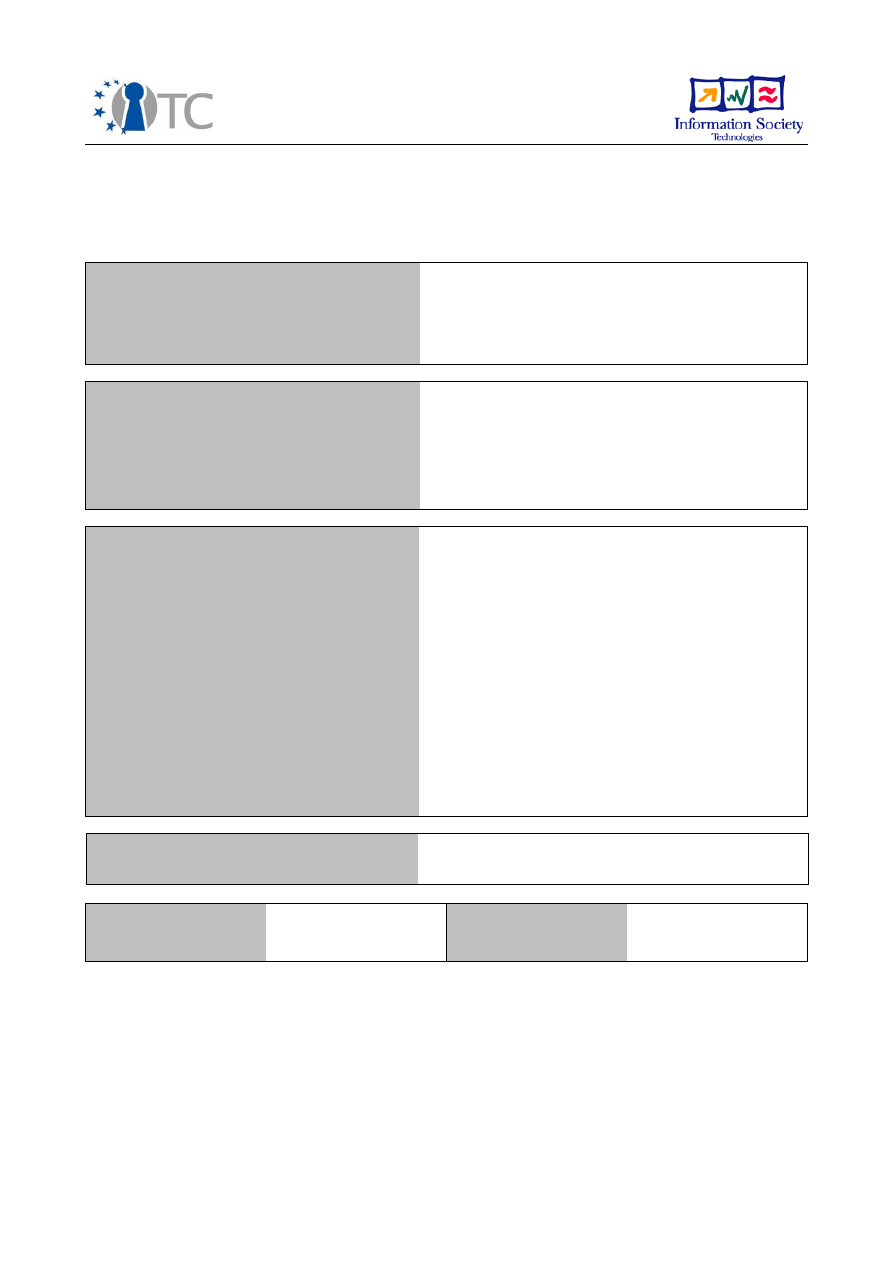
WP06a Preliminary DRM system specification
Project number
IST-027635
Project acronym
Open_TC
Project title
Open Trusted Computing
Deliverable type
Internal document
Deliverable reference number
IST-027635/D06a.1/FINAL | 1.10
Deliverable title
Preliminary DRM system specification
WP contributing to the deliverable
WP6
Due date
Apr 2007
Actual submission date
Apr 2007
Responsible Organisation
LDV,Lehrstuhl für Datenverarbeitung, TUM
Authors
Florian Schreiner, Chun Hui Suen
Abstract
Keywords
DRM, fair, interoperable, MPEG-21
Dissemination level
Public
Revision
FINAL | 1.10
Instrument
IP
Start date of the
project
1
st
November 2005
Thematic Priority
IST
Duration
42 months

D06a.1 Preliminary DRM System Specification
FINAL | 1.10
Table of Contents
1 .Introduction............................................................................................................... 5
2 .Use Cases.................................................................................................................. 5
2.1 Overview................................................................................................................ 5
2.2 Description of Use Cases........................................................................................ 6
3 .Design Specifications............................................................................................... 13
3.1 Architecture.......................................................................................................... 13
3.2 Player API............................................................................................................. 13
3.2.1 Registration..................................................................................................... 13
3.2.2 Content Key Handling...................................................................................... 14
3.2.3 Legacy Player Application................................................................................ 14
3.3 Manager API......................................................................................................... 15
3.4 Application loader................................................................................................ 15
3.5 Core Manager....................................................................................................... 15
3.6 License Manager.................................................................................................. 15
3.6.1 License Interpreter.......................................................................................... 16
3.6.2 License Translation Manager .......................................................................... 16
3.7 State Management............................................................................................... 17
3.8 Sealed store......................................................................................................... 18
3.8.1 Key store......................................................................................................... 18
3.8.2 License store................................................................................................... 18
3.9 Utility library......................................................................................................... 18
3.1 0OS Services........................................................................................................ 19
4 .Component Interaction............................................................................................ 20
4.1 Functional parts of the DRM Core ........................................................................ 20
4.2 Sequence diagram............................................................................................... 21
4.3 DRM system and XEN/L4 virtualization environments.......................................... 22
4.3.1 DRM components and compartments.............................................................. 22
4.3.2 Interfaces between compartments.................................................................. 23
5 .Requirements from other Partners...........................................................................24
6 .Technical API Specification...................................................................................... 25
6.1 External Interfaces............................................................................................... 25
6.1.1 class PlayerInterface........................................................................................ 25
6.1.2 class ManagementInterface............................................................................. 26
6.1.3 class Utility...................................................................................................... 26
6.2 Internal Interfaces................................................................................................ 27
6.2.1 Class DatabaseManager.................................................................................. 27
6.2.2 Class InterpreterInterface................................................................................ 28
6.2.3 class SystemState........................................................................................... 29
6.2.4 class CoreManager.......................................................................................... 29
6.2.5 class LicenseManager...................................................................................... 29
6.2.6 class LicenseTranslationManager.................................................................... 30
6.2.7 class StateManager......................................................................................... 31
6.3 Helper Classes...................................................................................................... 32
6.3.1 class ItemReference........................................................................................ 32
6.3.2 class ItemState................................................................................................ 32
6.3.3 class Key.......................................................................................................... 32
6.3.4 class License.................................................................................................... 33
6.3.5 class PlayerState............................................................................................. 33
6.3.6 class REL.......................................................................................................... 34
Open_TC Deliverable D06a.1
2/39

D06a.1 Preliminary DRM System Specification
FINAL | 1.10
7 .Annex A : C++ Header definition............................................................................. 36
8 .Glossary of Abbreviations........................................................................................ 38
9 .References............................................................................................................... 39
Open_TC Deliverable D06a.1
3/39

D06a.1 Preliminary DRM System Specification
FINAL | 1.10
List of figures
Figure 1: System Overview........................................................................................... 13
Figure 2: License Translation........................................................................................ 17
Figure 3: Internal and external components of DRM Core............................................ 20
Figure 4: Sequence diagram for media playback......................................................... 21
Figure 5: Virtualization of the DRM Core.......................................................................22
Figure 6: Interface Chain.............................................................................................. 23
Open_TC Deliverable D06a.1
4/39

D06a.1 Preliminary DRM System Specification
FINAL | 1.10
1. Introduction
This document collects the preliminary specifications of a DRM system to be
developed as sample application for the OpenTC framework. These specifications
define the scope of system, describe its functional requirements and its design. The
design sections of this document are mainly focused on the definition of the system
architecture by depicting the system modules, the function of each of them and the
related interactions.
The formats for the data exchanged between the external modules, like the between
the OpenTC Player and DRM Core, have not yet been defined. Moreover the
interactions with the services provided by OpenTC framework are just outlined and
exposed in terms of requirements, since the definition of the interfaces to those
services is still an ongoing activity within the workpackages three to five. The exact
details of these interactions and definition of the formats for the data exchanged
between the components of the DRM system will be included in the final
specifications.
The principal scope of the OpenTC DRM system will be the protection of multimedia
content. Generalization of the DRM system for the protection of other contents, such
as personal data, secret information or medical records of the patients, would be
possible through extension of the OpenTC DRM system. However, specific
implementation of such generalization will not be implemented in this sub-
workpackage.
This document is organized into 9 sections. Section 2 describes the functional
requirements in terms of use cases while sections 3 and 4 include the design
specifications of the system. Section 5 shows the requirements for this application
within the OpenTC System. Section 6 describes a preliminary API used to access the
DRM Core, and its key functions. Section 7 is a normative API definition in C++, while
sections 8 and 9 provide glossary and references to the terms and technologies used
in the DRM system.
2. Use Cases
2.1 Overview
The Interoperable DRM system application scenario describes a DRM system that is
based on Trusted Computing and MPEG-21 for protecting multimedia content. The
system can be divided in 2 main parts: the DRM Core and the secure application.
The DRM-core is an operating system component that handles the content licenses
and the content keys. It exposes this functionality through an application
programming interface (DRM Core-API) to applications. The DRM-core is responsible
for parsing licenses, deciding on whether access to requested content is allowed and
managing the content keys.
The secure application in the simplest case a media player. The application uses the
DRM Core-API provided by the DRM-core to gain access to protected content. After a
verification process, the application receives the content key from the DRM Core and
is able to render the content.
The user can perform different actions with the secure application. Every action
Open_TC Deliverable D06a.1
5/39
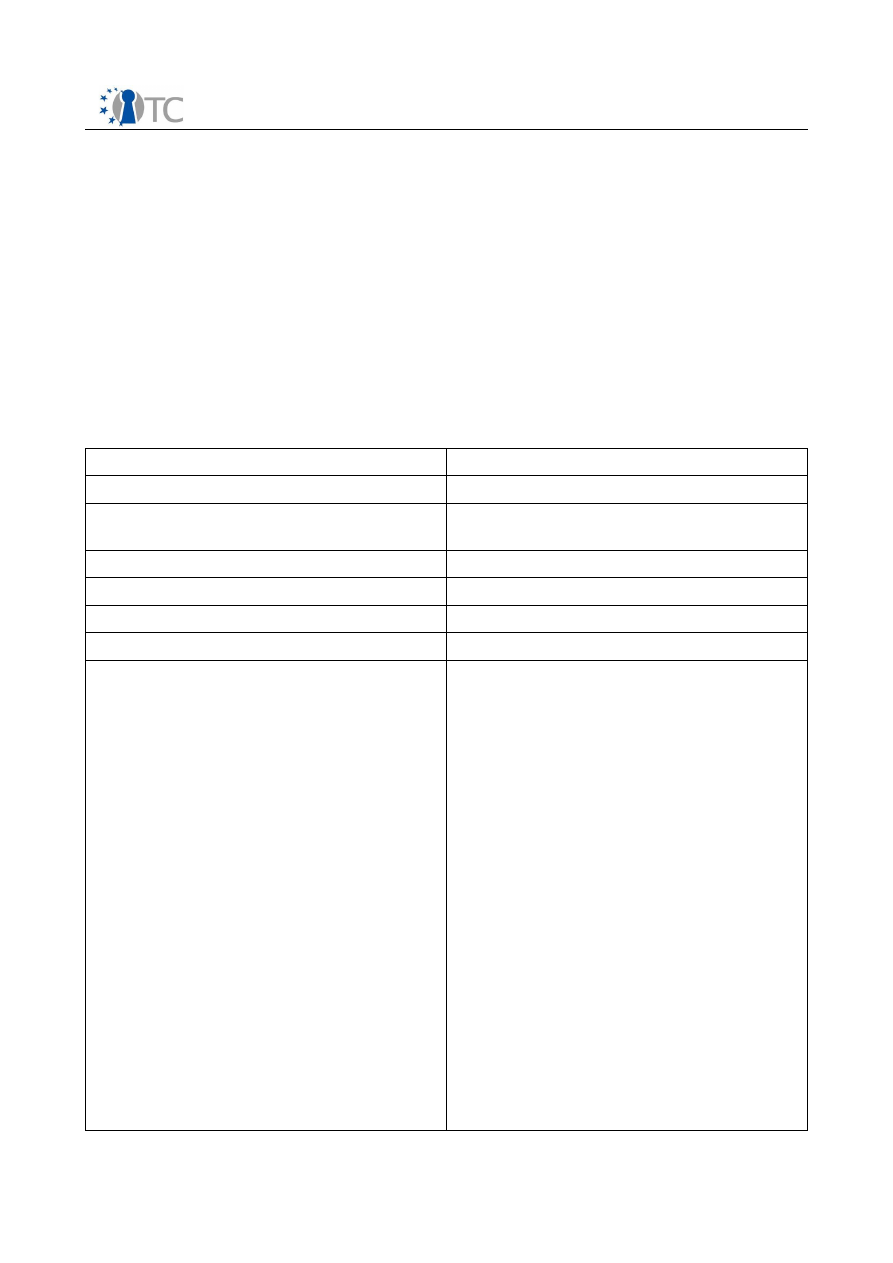
D06a.1 Preliminary DRM System Specification
FINAL | 1.10
triggers a process between the application and the DRM Core. For the DRM system we
differentiate between these 5 main actions:
–
Initialization of the system
–
Download content
–
View / Play Content
–
Renew License
–
Transfer License
In the following sections these different use cases are explained in detail. They
describe step by step, what happens when the user intends to perform an action.
2.2 Description of Use Cases
Use Case Unique ID
/ UC 10 /
Title
Initialization of the system
Description
The administrator initializes the DRM
System within the OpenTC framework.
Actors
Administrator
Preconditions
The OpenTC framework was started.
Postconditions
The DRM Core was initialized.
Comment
Normal Flow
1. The Administrator installs a DRM-
Core and starts it in a separate
compartment.
2. The Administrator installs user
space applications, that can be
executed in the secure
environment for rendering of the
content.
3. The administrator establishes the
following requirements:
•
Trusted I/O Channels: We need
a secure audio and video output
path for rendering content.
•
Access to the trusted services
from the compartment,
especially to the DRM Core and
the TSS Stack. Access to the
Core will be limited by its API.
•
Ability to display an application
in a Window-System, which is
started in the secure
environment. An efficient
method for video rendering
should also be supported in a
Open_TC Deliverable D06a.1
6/39

D06a.1 Preliminary DRM System Specification
FINAL | 1.10
secure manner (for example
Overlay).
•
Integrity measurement of all
applications and plugIns that
can be used to reproduce
content in a secure way.
Open_TC Deliverable D06a.1
7/39
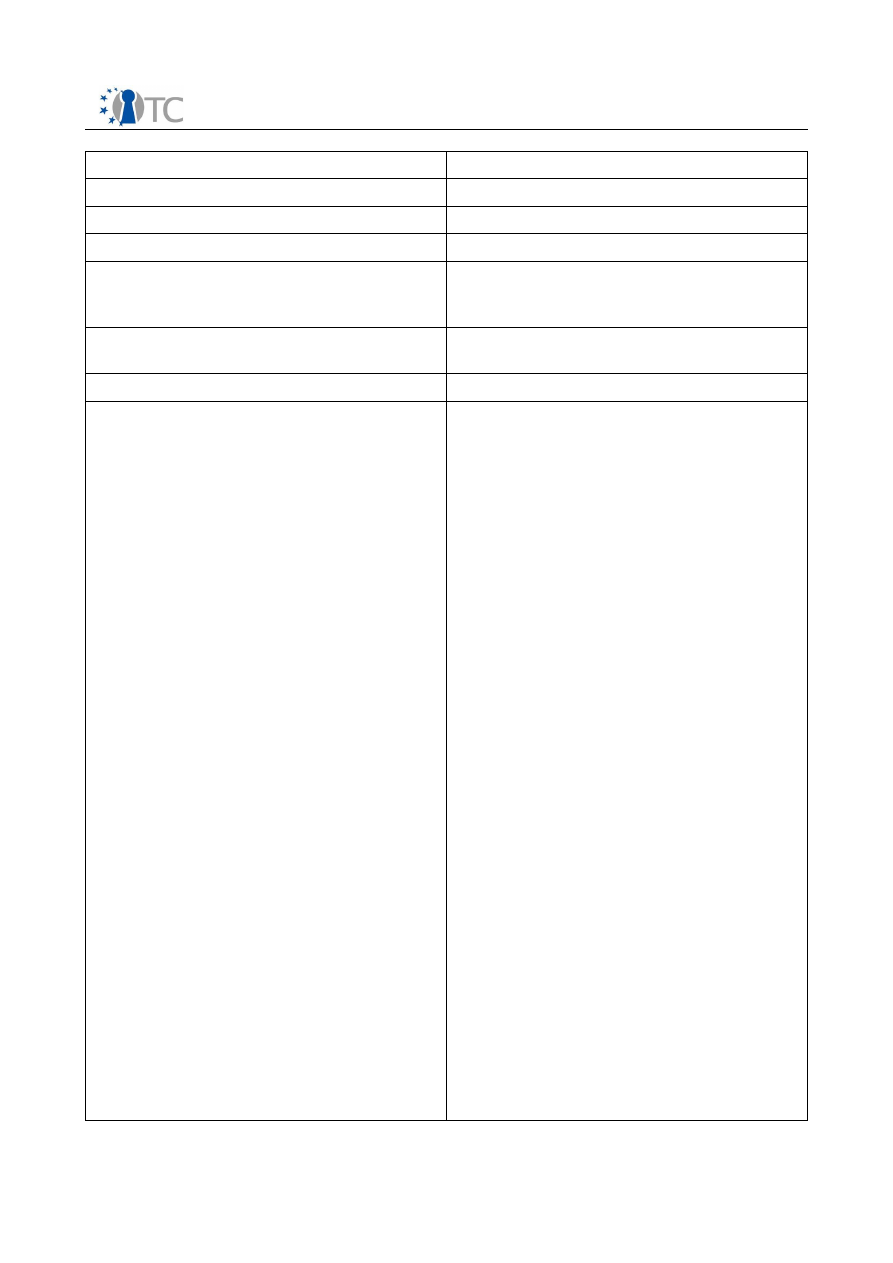
D06a.1 Preliminary DRM System Specification
FINAL | 1.10
Use Case Unique ID
/ UC 20 /
Title
Download content
Description
The user downloads a content.
Actors
User
Preconditions
The OpenTC framework was started and
the DRM Core is running in a secure
environment.
Postconditions
The content keys and the license are kept
secure in the sealed storage.
Comment
Normal Flow
1. The user downloads a container file
either from a provider or another
user. The file consists of the
multimedia content. The
downloading and the storage can
be unsecured, because the data is
always encrypted.
The license can also be transferred
in this step. It doesn't need to be
protected, since it is signed by the
content provider.
2. The user initializes the secure
environment.
3. The user starts the player
application for the retrieval of the
content keys.
4. The player application establishes a
secured connection to the provider
for exchanging the content keys.
5. The DRM Core starts a mutual
authentication round. The keys may
only be transferred when the
existence of a trusted DRM-core
within a secure environment is
detected at the receiver side, thus
the download procedure may start
after a successful authentication.
The authentication is planned to be
based on remote attestation and
generation of attestation identity
keys (AIKs) by the TPM.
6. The DRM Core exchanges the
content keys. The keys are
managed by the DRM-core, which
stores them in a central key store
along with a Digital Item Identifier
(DII). The same identifier resides in
Open_TC Deliverable D06a.1
8/39

D06a.1 Preliminary DRM System Specification
FINAL | 1.10
the license within the content
container. The content key
download procedure may be
separate to the content download
procedure, but always takes place
under the DRM-core's control.
7. The license for the content is
checked and preprocessed. The
important information of the license
is stored in the sealed store.
Open_TC Deliverable D06a.1
9/39
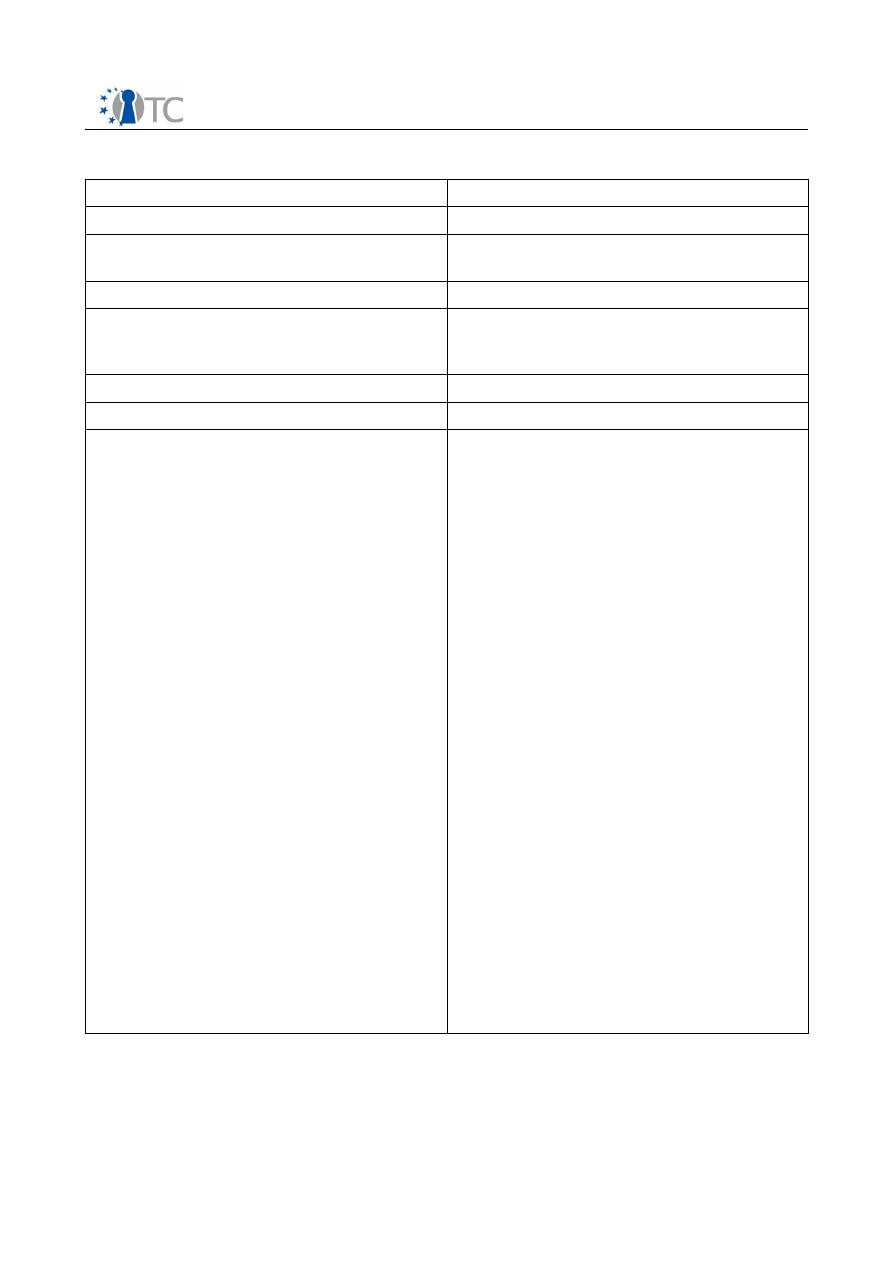
D06a.1 Preliminary DRM System Specification
FINAL | 1.10
Use Case Unique ID
/ UC 30 /
Title
View / Play content
Description
The user tells the player that he wants to
view the content of a protected file.
Actors
User
Preconditions
The OpenTC framework was started and
the player application and DRM Core are
running in a secure environment.
Postconditions
Comment
Normal Flow
1. The user starts a player application,
which runs in the secure
environment.
2. The user triggers the application to
access a protected media file for
rendering.
3. The player application registers
with the DRM-Core. Then it asks the
DRM-core through the API to enable
access to the protected information
by handing out the content key
from the key store.
4. The Core is presented with the
content's license from the
container file along with the
requested action (e.g. play, print,
modify etc.) and decides on
whether access is granted or not. If
yes, the DII is used to query the
key store for the content key. The
key store itself is an encrypted file
and is protected by sealing its key
to a trusted system configuration.
Thus, the core can only access the
key store when the system is in a
known trusted state.
5. Then the DRM-Core hands out the
content key to the application. It
poses no threat since the system
and the player application are
trusted.
Open_TC Deliverable D06a.1
10/39

D06a.1 Preliminary DRM System Specification
FINAL | 1.10
Use Case Unique ID
/ UC 40 /
Title
Renew License
Description
Generally licenses are valid until a final
date. After this date, the license expires
and the user has to renew his license from
a license server.
Actors
User
Preconditions
The OpenTC framework was started and
the DRM Core is running in a secure
environment.
Postconditions
New license is stored securely in the
sealed storage.
Comment
Normal Flow
1. The user triggers the license
renewal and the player application
connects to the content provider.
2. The DRM-Core performs an
authentication procedure similar to
that in the download procedure.
3. The player application replaces the
existing license by a new one.
Open_TC Deliverable D06a.1
11/39
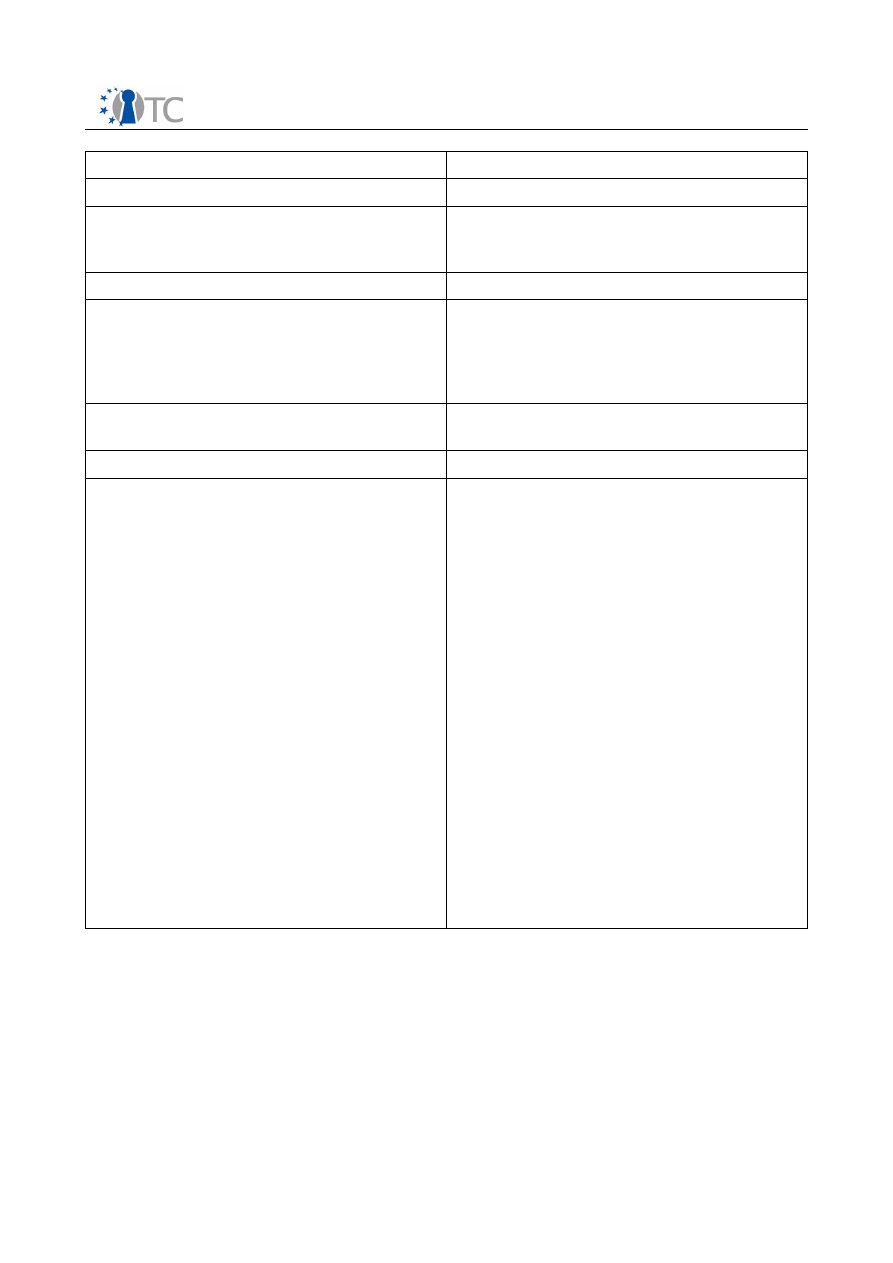
D06a.1 Preliminary DRM System Specification
FINAL | 1.10
Use Case Unique ID
/ UC 50 /
Title
Transfer License
Description
Licenses are transferred to other
computers or are translated to other DRM-
Systems.
Actors
User
Preconditions
The OpenTC framework was started and
the DRM Core is running in a secure
environment. Manager application and
target DRM system are running in a
secure environment.
Postconditions
Transferred license is stored secure in
target DRM system.
Comment
Normal Flow
1. The user initiates a transfer.
2. Then the Manager application
establishes a secure and
authenticated connection between
the two systems. The license and
content key are transmitted
securely. A similar authentication
procedure as in the download and
renew license use case is required.
3. In case a different DRM system
needs to be supported, the existing
license must be translated by the
DRM Core. The translation may also
require a re-encryption of the
content. Furthermore, the
translated license has to be signed
by the DRM Core, which will use the
TPM to enable trust to its signature.
4. The player application transmits
the content itself. This is not a
security problem, since the
transferred data is always
encrypted.
Open_TC Deliverable D06a.1
12/39
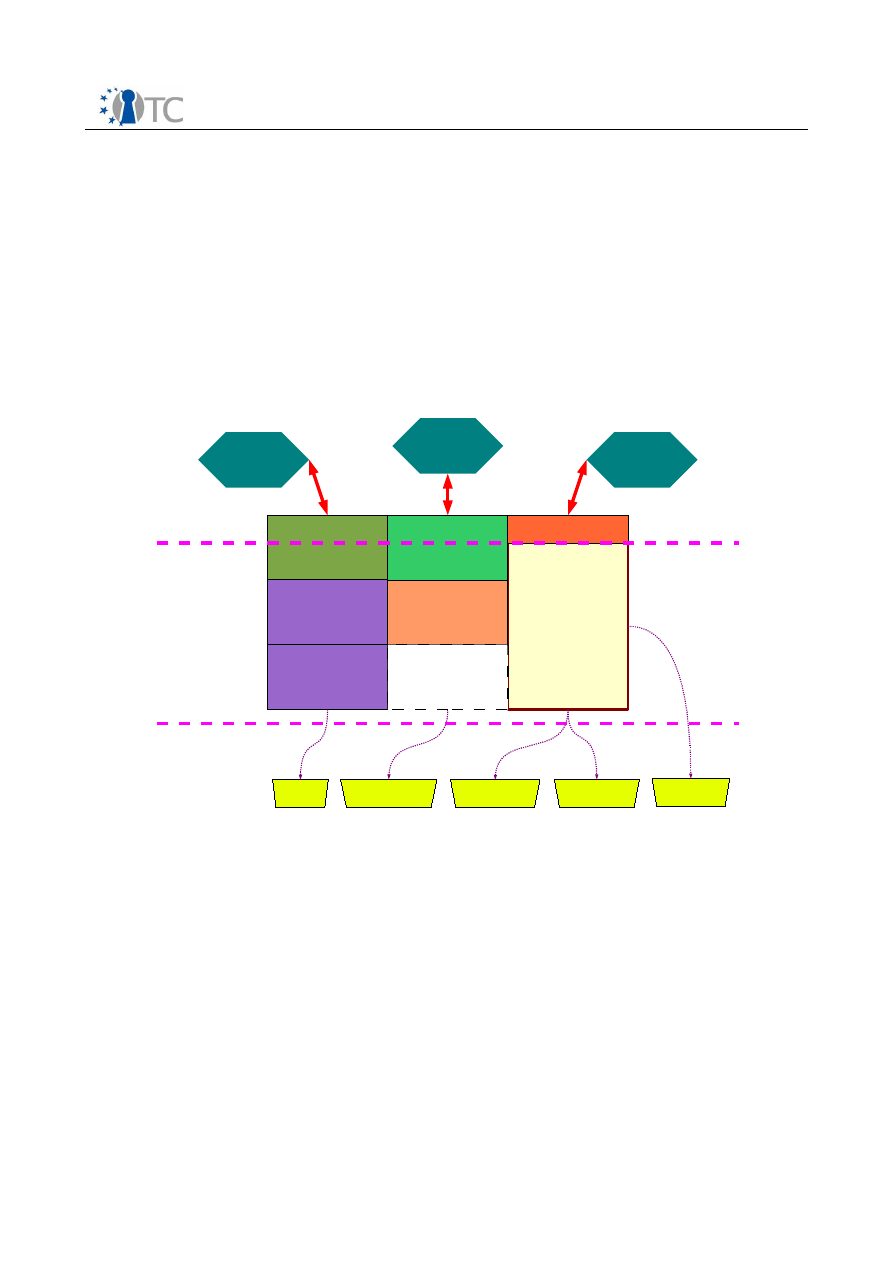
D06a.1 Preliminary DRM System Specification
FINAL | 1.10
3. Design Specifications
3.1 Architecture
The diagram below shows the major components which make up the OpenTC DRM
system. The entire system can be divided into 3 sections, namely applications running
in userspace, the DRM Core which is running in a secure compartment, and security
services provided by the operating system and compartment management. The
precise separation of the system components among different secured compartments
is explained in section 4.3. The following sections will explain the individual
components of the system in detail.
3.2 Player API
3.2.1 Registration
Each Player who wants to access a protected content must register with the DRM Core
first. During Registration a mutual authentication is performed, so that the Player and
DRM Core validate the integrity and security status of the other party.
Additionally, the Core gets some information about the player, e.g. the version number
or process information, so that the Core can distinguish between multiple Players on
the same machine. After the authentication the capability negotiation follows, where
the Core negotiates a common rule set with the Player instance. This rule set defines
the REL commands, that both, Player and Core, have a common understanding of. This
mechanism enables the Core to discover, which commands the player supports and in
Open_TC Deliverable D06a.1
13/39
Figure 1: System Overview
License
Manager
(License
Interpretation
& Translation)
Player
API
Manager
API
Core
Manager
Sealed storage
(Key/License
Store)
Application
Loader
Sealing
Secure Time
Attestation
Crypto. Lib.
Measurement
Player
Manager
GUI
I/O
OS-Services
DRM
Core
Userspace Applications
Utility Library
State
Management

D06a.1 Preliminary DRM System Specification
FINAL | 1.10
what way the Core can control the Player.
This restriction description can be done by using the subset of REL commands related
to representing conditions on operations, time and state. This allows a well defined
command set to be used, without defining a new standard. The specific command set
is not defined in this preliminary document.
After successful registration, the player is considered trustworthy to handle the
protected content in a correct and predictable way.
3.2.2 Content Key Handling
After a successful registration the player can request the content key for a particular
protected content. This triggers a process of retrieving the associated license(s) of the
selected content and interpretation of this license. The Core then comes to the
decision if the player is allowed to access the content or not. This “Result” is described
in a XML format similar to the MPEG-21 REL and is transmitted to the Player.
If the Result is positive and the Player is generally allowed to access the content.
Together with a positive Result, the Core also transmits the content key so that the
Player can decrypt the content.
Furthermore the Result may contain several additional conditions, which have to be
enforced during the process of rendering. The content provider can define these
conditions to specify in what way the content can be rendered. An example condition
would be that the player should play only the first 10 seconds of a song. The player
has to understand these conditions in order to be able to enforce it correctly.
The capabilities of the player for these conditions are negotiated during the
registration, so the Core knows which conditions the player is able to enforce. For
example during the registration, the player informs the core, that he is able to enforce
the rule “play only the first x seconds” and the Core saves this property in an internal
storage. When a license is validated and this rule should be applied for the value 10,
then the Core generates a Result, which contains the rule that states “play only the
first 10 seconds”.
Decryption Modules are needed, when the Player receives a positive Result and then
wants to decrypt a specific content. Generally every content can use its own
encryption algorithm depending on the producer of the content. If the Player wants to
decrypt these contents, he needs access to all corresponding encryption libraries. This
functionality is provided by the Utility Library, which the player can use to get access
to a corresponding implementation of the encryption algorithm. The Utility Library is a
part of the API and provides a standardised interface for essential algorithms. The
mechanism within the Utility Library is explained in section 3.9.
3.2.3 Legacy Player Application
All specifications in the API are standardized and can be used by the player
applications. Generally the Player should be compatible to the DRM-System to know
the API of the core and how to handle content. Legacy players, which cannot access
the API directly, are also supported by our architecture. Players of that kind are not
aware of the DRM Core, but maybe favored by users for whatever reason. These cases
are handled by an IO-Socket interface, in which the handling of license authentication
and interpretation occurs transparent to the application.
Open_TC Deliverable D06a.1
14/39

D06a.1 Preliminary DRM System Specification
FINAL | 1.10
For the player, the whole process is similar to a normal file access. The player only has
to support the content’s type and be connected to the IO-Socket through a plug-in.
The player receives the unprotected content from the socket and can render it. The IO-
socket in this case converts and forwards requests through the API to the DRM Core.
Since all applications, including the legacy ones, run in the secured environment,
handing out the content key or the decrypted content itself is no problem, since it is
guaranteed that the applications cannot compromise it.
3.3 Manager API
Manager API provides an interface to management features of the DRM Core, such as
inserting new licenses into the DRM Core and requesting for attestation keys. The
Manager GUI uses this API (defined in
ManagementInterface
), so that playback and
administrative functions of the DRM Core are clearly separated.
3.4 Application loader
The initial loading of the DRM Core needs to be done in a secure manner. This should
be handled by the compartment and device manager, which will check the integrity of
the compartment image before loading the DRM Core. In addition to the main image, a
secure persistent storage is used to provide secure storage for the DRM Core, that will
be discussed in sections 4.3.1 and 4.3.2.
3.5 Core Manager
The central component of the system is the Core Manager. It's tasks are the central
management of the different parts of the DRM-Core. It coordinates the requests from
the application layer and forwards them to the appropriate components. It also
contains the error handling e.g. fail over, treatment of invalid data, error logging and
exception handling.
3.6 License Manager
The core manager implements the interface to the Player and Manager GUI, and
coordinates the management and enforcement of licenses. When the player wants to
decrypt a protected content for a particular action, it sends a request to the core
manager, with a reference to the protected content and the request parameters. This
request contains the rights and the corresponding license, which have to be verified. A
request may also consist of multiple licenses.
Upon request from the player, the DRM Core makes the appropriate query to the key /
license storage, and sends the complete request to the license manager. In this case
the License Interpreter has to verify each license and determine if the right may be
granted over the content.
Depending on the license type, this is performed by the appropriate license
interpreter, generating an internal representation of the license. When the license is
positively authorized, the content key is retrieved from the key storage and returned
to the player with appropriate player restriction description.
When this player restriction needs to be adapted, or if a license is requested, then the
query is passed to the license translation manager.
Open_TC Deliverable D06a.1
15/39

D06a.1 Preliminary DRM System Specification
FINAL | 1.10
3.6.1 License Interpreter
The licenses, that are stored in the sealed storage are in an XML format. Before these
licenses can be interpreted, license parsing needs to be carried out. This process maps
a license into an internal representation suitable for interpretation.
The parsing process takes place in two steps. First, the formal integrity of the received
data is validated, for e.g. XML-formatted licenses this includes schema- or DTD-
validation.
In the second step the authenticity and integrity of the data must be validated. The
most utilized approach is using digital signatures on the license, like XML dsig,
together with X509 based certification chains. To leave the possibility to extend the
concept to new formats, the signature checking uses the utility library as plug-in
architecture for the verification.
After the parsing of the license, the interpretation can be performed. In this process
the internal representation of the license is matched against the operation request
from the player application. The matching returns either a positive or negative result.
A positive result implies that the player application is allowed to decrypt and render
the specified content. However, depending on the license, a positive result may also
include additional restrictions which the player must support and enforce.
The OpenTC license model strives to support the concept of a “fair” DRM system as
well, meaning that the resulting systems will be beneficial not only for the content
provider, but also the consumer of a content. It is thus planned that all participants in
the system will be treated equally, so that every participant can either act like a
content consumer or a content provider. A content provider can use the system to
protect his own creation against any misuse.
Nevertheless the content provider can still decide to restrict the usage of the content
in an “unfair” way. This decision isn't based on a technical problem, but rather a
consequence of the business model. In order to have a fair usage of DRM, each
participant has to consider carefully its business model. The business model should
provide different added-value to the user, by granting additional rights to the user. We
foresee the following rights, which would support a “fairer” usage of DRM:
●
copy
●
burn
●
sell
With the right to “copy” the consumer can create a limited amount of private copies.
By transferring these copies, the content can be shared with a small number of
OpenTC devices, which belong to the domain of the user. This domain has to be
defined beforehand, with a specified maximum number of devices.
In the same way, the right “burn” grants the user to save the content on a disc. “Sell”
means, that a consumer can sell the content to another user. With these technical
possibilities, the DRM works almost transparently to the consumer.
3.6.2 License Translation Manager
In order to support interoperability between different systems, we propose to include a
license translation system, to support the translation of licenses between different
license description schemes, e.g. Open Mobile Alliance (OMA) REL, Digital Video
Open_TC Deliverable D06a.1
16/39
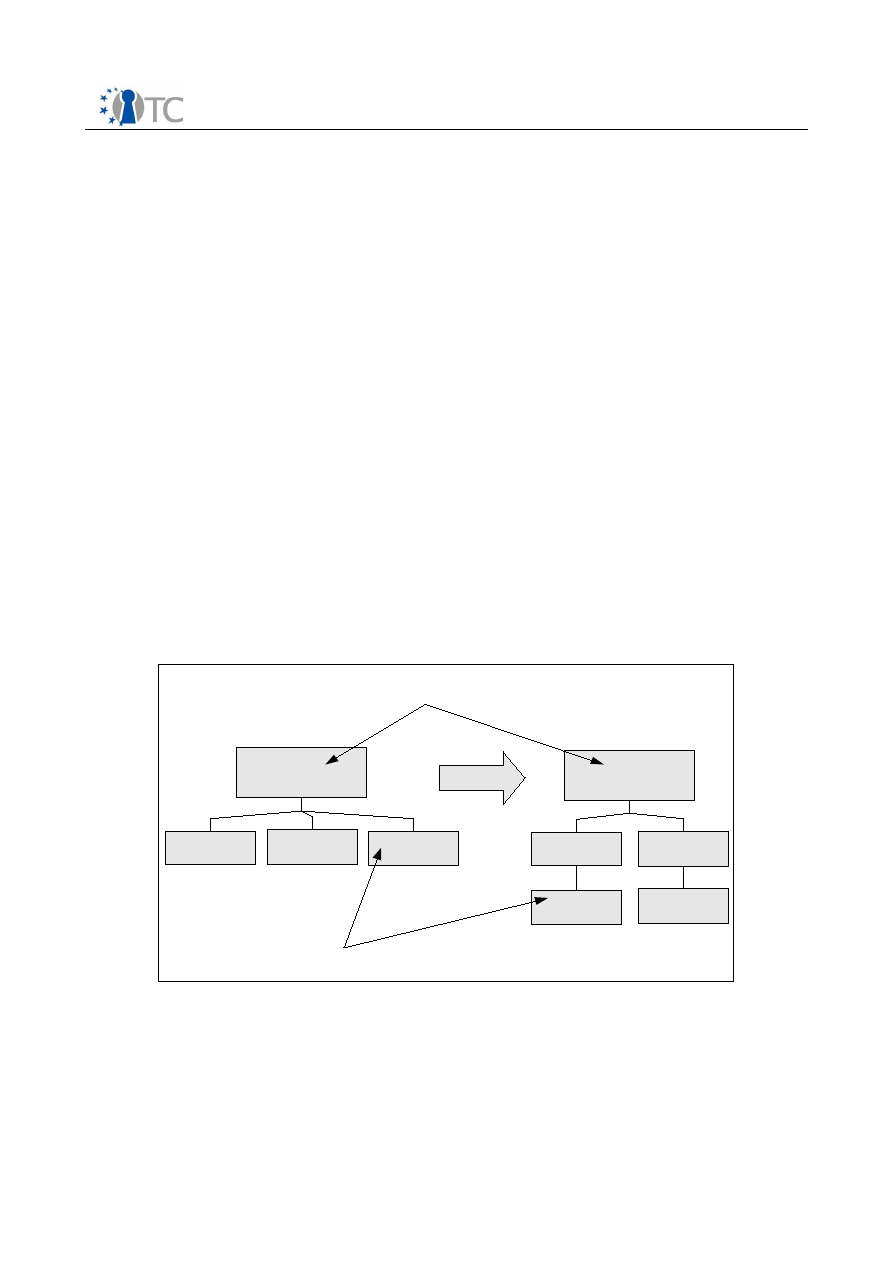
D06a.1 Preliminary DRM System Specification
FINAL | 1.10
Broadcast Content Protection or Content Management DVB-CPCM. This allows content
to be received from or exported to foreign DRM systems or to external devices which
do not support the MPEG-21 REL license format.
This enables a seamless experience for the user, by allowing multimedia content to
easily move between different interoperable systems and devices.
The parsing of the license to be translated is first performed, which creates an internal
representation of the license. This is then handed to the translation engine with the
required translation requirements, such as target license language and profile.
Requirements for the translation system are:
●
Element name translation / adaptation
●
Restructuring of license elements to a legal structure in the other language
●
Contractive translation of unsupported elements
Figure 2 shows the translation between two license languages. Element renaming can
be handled trivially, but restructuring and contractive translation (where an alternative
description must be generated that best matches the original element) of elements
not found in the original language, will require intelligent rules for such
transformation.
The proposed solution is to use an expert system architecture to transform a
knowledge representation of the original license into another license language.
Transformation rules can be built to translate the element names, make appropriate
contractive translation of elements which are not found in the target language, and an
output phase which generates the output license in a different structure.
3.7 State Management
The State Manager is responsible for managing system and license-related states.
System states are a general framework to access information related to the DRM
Open_TC Deliverable D06a.1
17/39
Figure 2: License Translation
grant
agreement
play
print
Tim e
condition
play
print
Tim e
condition
*
Tim e
condition
*
E lement rename
R es tructure &
contractive trans lation

D06a.1 Preliminary DRM System Specification
FINAL | 1.10
system (such as current player capabilities and credentials) and machine-related
parameters (such as time and location). License-related states are used to store
persistent information needed for license interpretation (such as playback counter).
3.8 Sealed
store
The sealed store consists of two parts: the key store and the license store.
3.8.1 Key store
A particularly important component of the core is the key store. The key store contains
the keys which are used to access (namely decrypt) the protected content in the
system. The DRM Core ensures that a content key is given out only when a requested
action is allowed by the license. The key store is organised as a table which contains
keys and unique content identifiers. The same identifiers are used in the licenses to
reference content. Respective technologies are part of the MPEG-21 standard. The key
store is implemented as a secure database, which is decrypted by the core when a
secure environment is established. This is done with the help of the TPM, which seals
the key storage master key, so that it can only be accessed when the system is in a
secure state. The core itself is thus only able to retrieve the master key when the
system has not been compromised.
3.8.2 License store
As described previously, License Interpretation Manager relies on an internal
representation of licenses. The structure of this Internal license store is similar to the
structure defined in MPEG-21. To speed up the evaluation of licenses by the License
Interpretation Manager, each single syntactic object of a license, namely principal,
digital item, grant and condition, is mapped to a specific internal object representation
that is optimized for the evaluation process. The internal storage offers some basic
search methods on the storage objects for selecting certain items based on different
criteria or for matching two items against each other. The license is also stored in the
secure database, to protect against any unauthorized change to the license outside of
the DRM Core. Regarding the semantic of the stored elements, we strictly use values
from the RDD-Standard issued within the MPEG-21 framework.
3.9 Utility library
In order to support an extensible DRM system, a utility library is provided to both the
player application and the DRM Core. This utility library provides a centralized
mechanism in which new tools for decoding, encryption, decryption, signing, and so
on, can be retrieved and made available.
The Player Application can request a decryption tool from the Utility library to be able
to decode the content. The DRM Core may also need cryptographic tools, for signature
verification or self-signing generated licenses (for instance, in the case of license
translation from another DRM system).
The Utility library follows the concept of MPEG-21 IPMP tools, in which tools for specific
functions can be identified and automatically retrieved for the target platform. This
allows the DRM Core and player to support new media (new codecs) and licenses (new
cryptographic tools) when newer tools become available.
Open_TC Deliverable D06a.1
18/39

D06a.1 Preliminary DRM System Specification
FINAL | 1.10
An important security aspect is that this utility library itself must be verified
beforehand, and must run within a secured environment. Mechanism to verify the
integrity of the retrieved tools, such as tool signing, must be implemented to ensure
that no security weakness is exposed through the new tool.
3.10 OS Services
The necessary OS services required by the DRM Core are secure time, sealing,
compartment measurement, attestation, cryptographic libraries. Secure time
mechanism provides a trustworthy source of time, on which time-related license
conditions can be verified.
Sealing of the license and key stores of the DRM Core, and measurement of the DRM
Core compartment should be performed by the OS compartment manager, prior to the
starting of the DRM Core compartment.
Services to aid the attestation of the DRM Core to services on the Internet, such as the
generation of AIK keys, need to be provided by the underlying OS.
Standard cryptographic libraries are also necessary in order to perform decryption and
hash operations as required by the DRM Core and Player application.
Open_TC Deliverable D06a.1
19/39
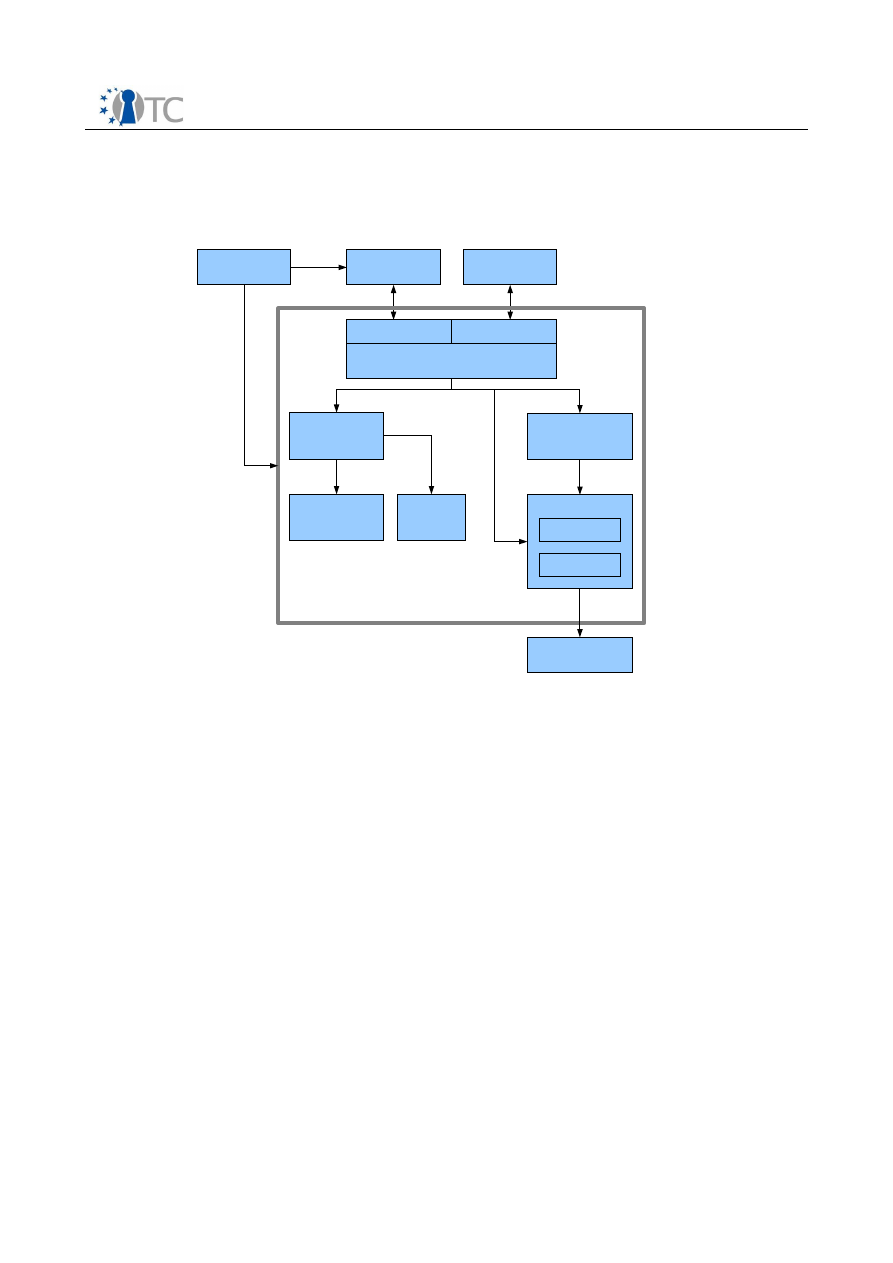
D06a.1 Preliminary DRM System Specification
FINAL | 1.10
4. Component Interaction
4.1 Functional parts of the DRM Core
The DRM Core consists of five key functional parts: The Core Manager, License
Manager, License Translation Manager, State Manager and Database Manager. The
Database Manager is a component that provides the access to the sealed storage.
Figure 3 shows the inter-relations of the different modules.
The Core Manager provides the API's to the user level applications. The Core Manager
is directly connected to the License Manager, the State Manager and the Database
Manager.
The License Manager can process licenses and then decides to which component the
license should be forwarded. If a license shall be interpreted, he uses the License
Interpreter, which parses the license and compares it to a given set of conditions. The
License Translation Manager is used, if a license has to be converted to or from other
DRM-Systems. The Manager can either import or export a license from another
compatible system.
The State Manager contains the current states of the applications and contents. It
monitors all players that are connected to the DRM Core and provides state
information about players, system and digital items.
The Database Manager has a connection to the key store and the license store. The
Core Manager can request specific keys and licenses from the Database Manager,
which are then retrieved from the key store or the license store.
Open_TC Deliverable D06a.1
20/39
Figure 3: Internal and external components of DRM Core
C ore M anager
Player Interface
Manager Interface
OpenTC Player
Manager GUI
Database Manager
S tate M anager
License
Manager
License
Translation
Manager
License
Interpreter
S ealed & encrypted
storage
Key store
License store
DR M C ore
Utility Library
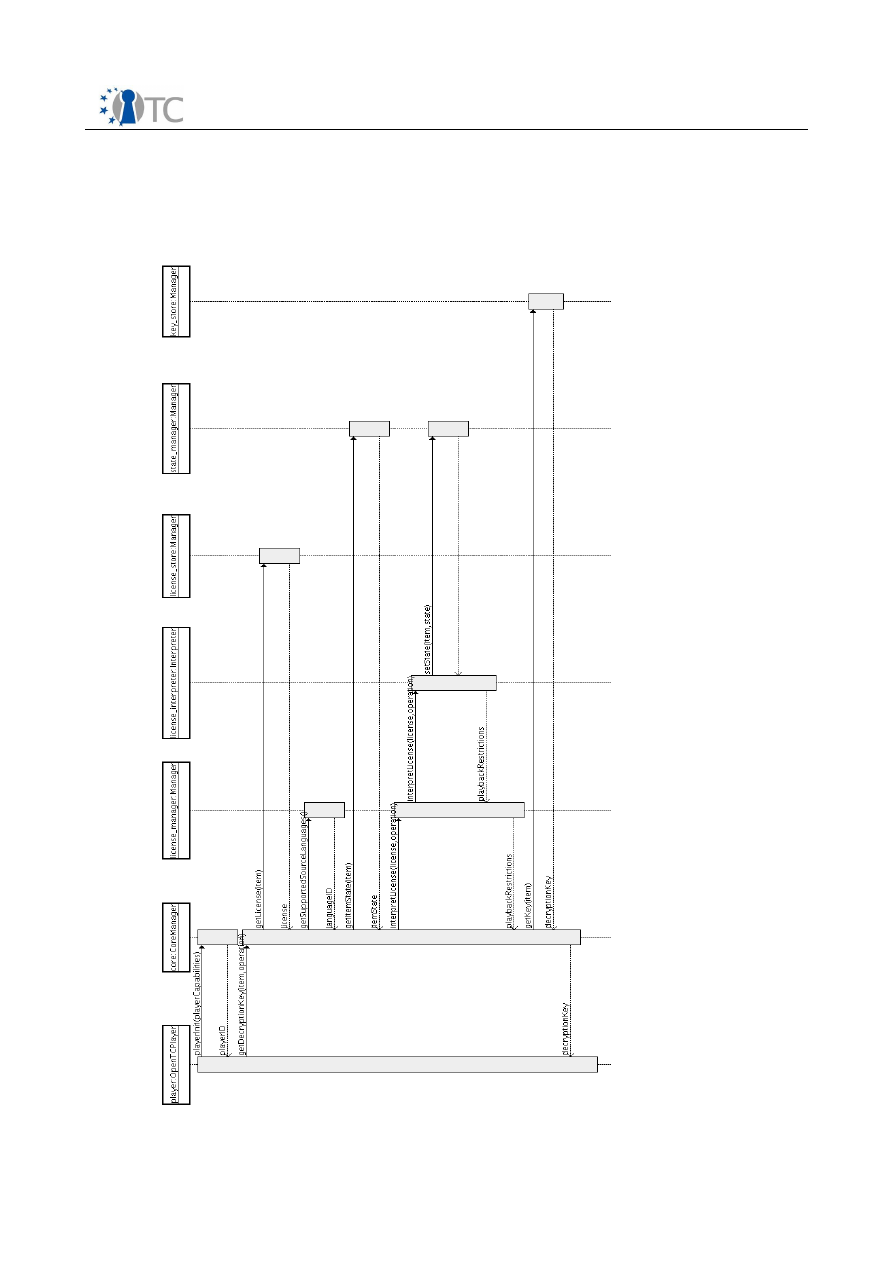
D06a.1 Preliminary DRM System Specification
FINAL | 1.10
4.2 Sequence diagram
Figure 4 shows the sequence diagram for interaction between the player and different
components within the DRM Core. The player application first performs an initial
Open_TC Deliverable D06a.1
21/39
Figure 4: Sequence diagram for media playback
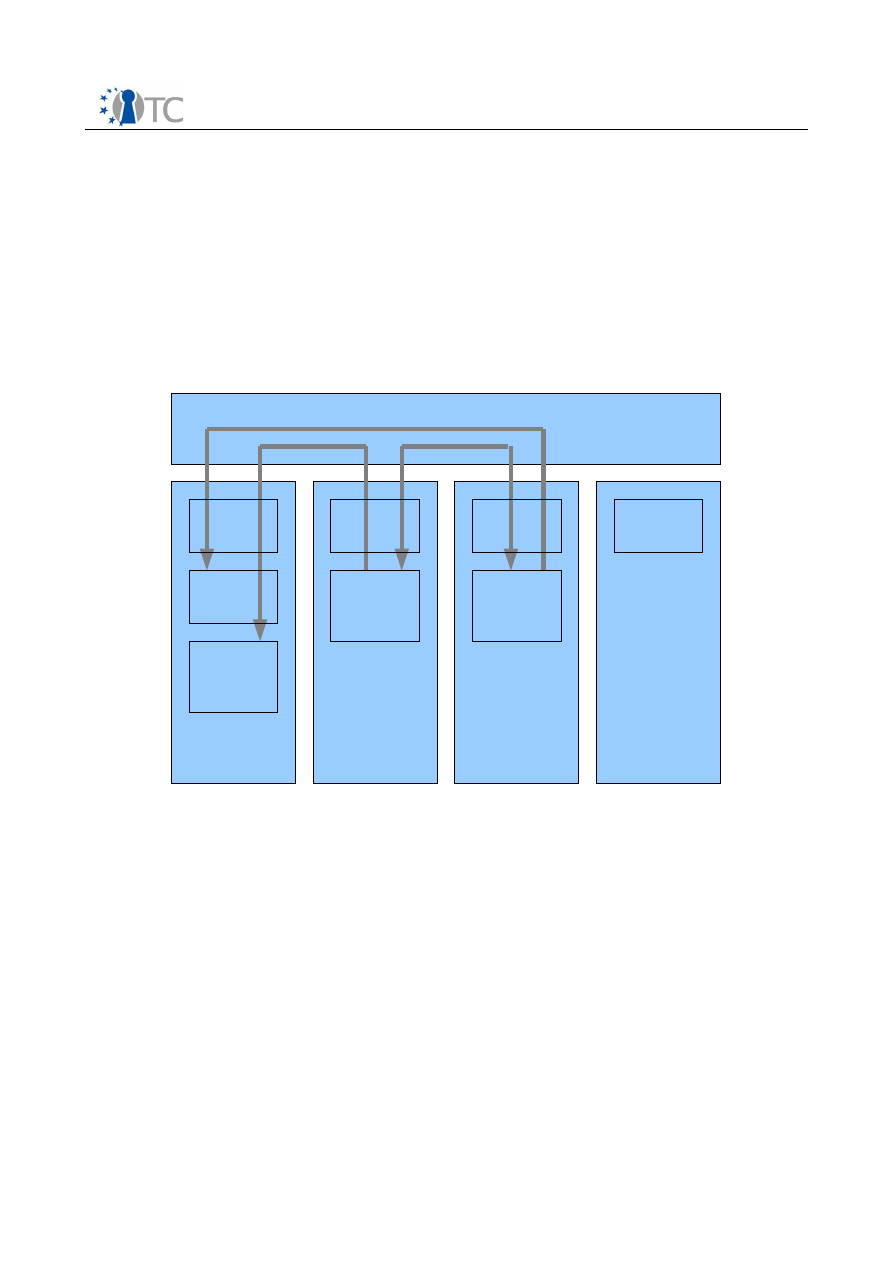
D06a.1 Preliminary DRM System Specification
FINAL | 1.10
handshake with the DRM Core by reporting its playback capabilities, and receives as a
response a
PlayerID,
which the DRM Core uses to identify different players
connected to the core. Upon the player requesting to decrypt a digital item, the core
manager handles the request and calls the appropriate modules within the DRM Core
to process the request. Upon success, the content key is retrieved and returned to the
player.
4.3 DRM system and XEN/L4 virtualization environments
4.3.1 DRM components and compartments
In order to take advantage of the secure application isolation provided by the
virtualization framework in OpenTC, higher security can be achieved by separating the
player application and DRM Core into separate compartments. Figure 5 shows virtual
machine partitioning of different components. The DRM Core as described in section 3
runs in a protected compartment, while the OpenTC Player runs in a different
protected compartment. Since the information traffic between the DRM Core and
player is not high, this is not a big performance penalty. The hypervisor, and OS
components such as kernel and drivers are not described in this document. Sealed
storage protects the key and license stores described in sections 3.8.1 and 3.8.2.
For the rendering of the content, the player needs access to device drivers/kernel
modules. This access is controlled by security policies which only allows
communication with signed device drivers/kernel modules in the service compartment.
This enforces the secure output path criteria. The DRM Core has access to a secure
storage provided by the service compartment. Sealing is used to encrypt this storage,
such that the DRM Core can only access it when the OS and the DRM Core are not
modified.
Open_TC Deliverable D06a.1
22/39
Figure 5: Virtualization of the DRM Core
Hypervisor
S ervice
C ompartment
Protected
C ompartment1
Protected
C ompartment2
Unprotected
C ompartment
kernel
S ealed
storage
DR M
C ore
S ecure
Application
kernel
kernel
kernel
S igned
drivers
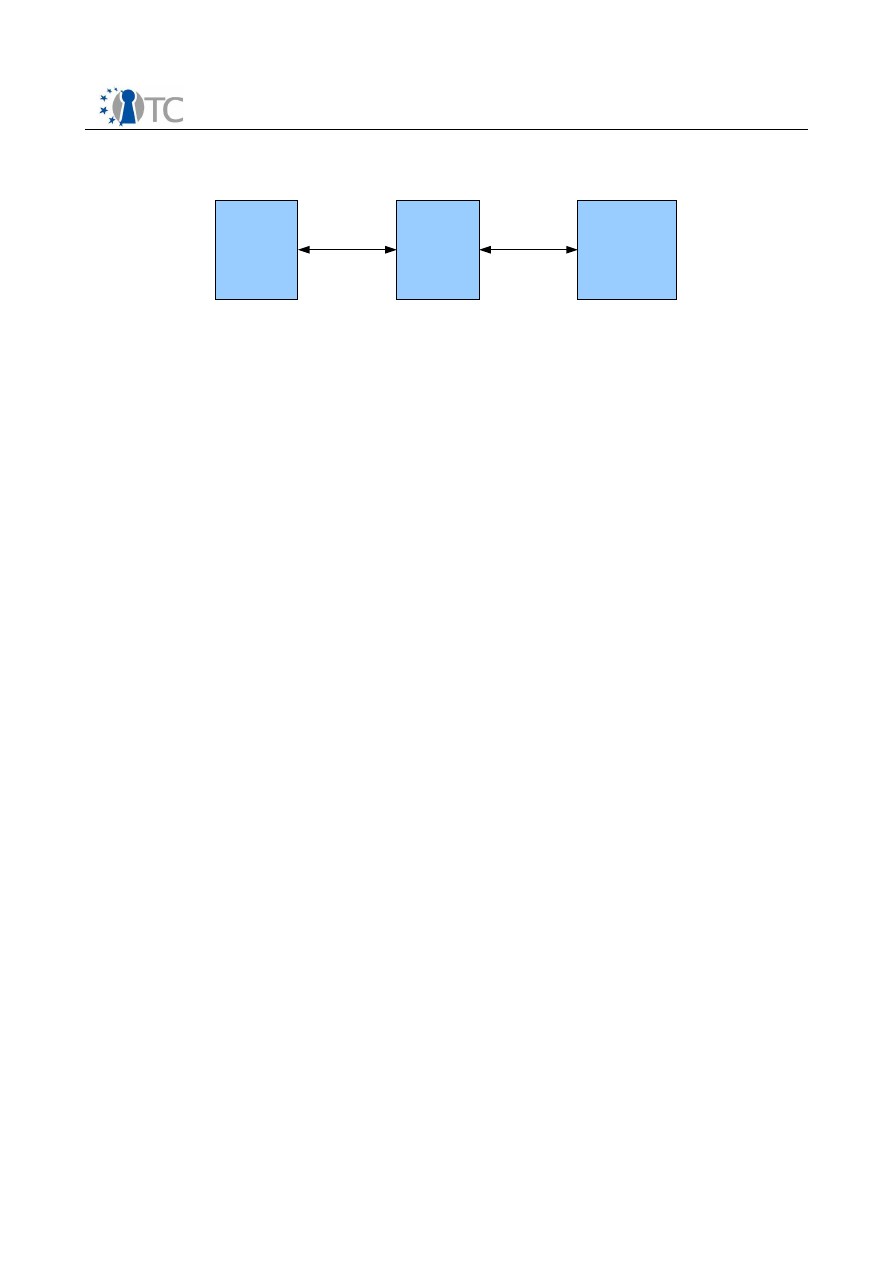
D06a.1 Preliminary DRM System Specification
FINAL | 1.10
4.3.2 Interfaces between compartments
A generic way to achieve communication between two compartments is the definition
of a network RPC between them. This form is used for the connection from the secured
application to the DRM Core. The security policy of the channel can be defined via an
interface from the operating system. Furthermore some rules of the license may have
to be applied, e.g. the content may not be rendered at the same time in more than
one player application. This RPC standard will not be defined in this preliminary
specification, but will be based on a standard RPC protocol, with a similar API as
described in section 3.2.
The interface between the DRM Core and secure sealed storage is implicit, in that it is
achieved by mounting secure mount points within the compartment of the DRM Core.
This is controlled by the compartment and device manager in service compartment.
The sealed storage is used for the storage of the licenses and the content keys.
Open_TC Deliverable D06a.1
23/39
Figure 6: Interface Chain
S ealed
storage
DR M
C ore
S ecure
Application
M ounted
directory
Network
R PC

D06a.1 Preliminary DRM System Specification
FINAL | 1.10
5. Requirements from other Partners
The secure application is generally a media player that uses the DRM Core-API to
render protected content. The application needs to be secure, because it is allowed to
decrypt the content. To maintain the security of the system, the player application
should run in a separate compartment, whose integrity and authenticity were checked
before its execution.
Furthermore the DRM system expects the presence of an underlying trusted system
and requires the following services from it:
●
Secure Environment.
The DRM Core and the media player application may
only execute when a secured environment is present. Thus, the underlying
system must provide:
●
Memory isolation and protection of processes running in the secure
environment.
●
Secure audio and video output paths to certified (signed) hardware
drivers and/or hardware. No unauthorized application or service
should be able to read from this output path. Optionally cryptographic
protection between the driver and the hardware can also be applied
when supported by the hardware.
●
A means to measure the integrity of the DRM system and associated
applications. This implies the existence of a method for measuring
applications before they are loaded and executed.
●
Cryptographic services.
The DRM Core requires several cryptographic
services which have to be provided by the underlying system:
●
A Trusted Software Stack (TSS), supporting AIK generation and
sealing. AIKs are required for authentication/remote attestation
purposes, while sealing is used to lock cryptographic keys to specific
system configurations. The core can thus ensure that content keys
are only accessible when the systems integrity is ensured.
●
Sealed Storage. The DRM Core will use sealed storage for its license
and key databases.
●
A system-wide database of certificates of root certification authorities,
along with services to verify certificates.
●
Central policy management.
Operation of the DRM Core and the media
player application will be subject to an operation policy of whatever kind. It
would be beneficial if the underlying system can provide a system-wide policy
management facility, so that DRM-related configuration can be seamlessly
integrated into the management tool.
Open_TC Deliverable D06a.1
24/39

D06a.1 Preliminary DRM System Specification
FINAL | 1.10
6. Technical API Specification
This section describes the API of critical classes and interfaces within the DRM Core.
This specification is based on the C++ language. Namespace used for the project is
defined to be
de_tum_ldv_opentc.
6.1 External Interfaces
Class interfaces which are to be accessed / called from outside the DRM Core are defined in this
section.
6.1.1 class PlayerInterface
This class provides the main external interface to the OpenTC player. It is defined
virtual
and is
implemented by the
CoreManager
class.
6.1.1.1
playerInit()
Function:
Initialize the player with an XML description of the
playercapabilities
Parameter:
Name
Type
Description
playerCapabilities
string
XML string describing player capabilities
Return value:
Type
Description
int
integer identifier representing the particular
player
6.1.1.2
getDecryptionKey()
Function:
Get content key from the DRM Core. This is the main operation used by the
player application to inform the DRM Core of a start of an digital item
operation (e.g. “Play”) and to obtain the appropriate content key.
Parameter:
Name
Type
Description
playerID
int
integer identifier representing the particular
player from
playerInit()
item
ItemReference
Reference to digital item
Return value:
none
6.1.1.3
getSupportedREL()
Function:
Query the DRM Core for supported REL languages
Parameter:
none
Return value:
Type
Description
list<REL>
List of languages supported by the Core
Open_TC Deliverable D06a.1
25/39

D06a.1 Preliminary DRM System Specification
FINAL | 1.10
6.1.2 class ManagementInterface
This class provides a second external interface for administrative functions to the DRM Core, such
as license management and controlling attestation.
6.1.2.1
insertLicense()
Function:
insert a signed license from a mutually attested source into the DRM Core
for a particular digital item
Parameter:
Name
Type
Description
license
string
XML string of license
relType
REL
REL language identifier
item
ItemReference
Reference to digital item
Return value:
none
6.1.2.2
getAttestationKey()
Function:
Obtain an attestation key to download trusted content from a trusted
source
Parameter:
Name
Type
Description
playerID
int
integer identifier representing the particular
player from
playerInit()
relType
REL
REL language identifier
serverURL
string
URL string of attestation server
Return value:
Type
Description
Key
Attestation key
6.1.3 class Utility
This is a utility class which provides a common mechanism for downloading tools for
commonly used functions, such as decryption and decoding, for both the DRM Core
and player.
6.1.3.1
getTool()
Function:
Function to retrieve a specific tool for a specific platform and application,
using a unique XML tool description
Parameter:
Name
Type
Description
toolDescription
string
XML tool description (based on MPEG-IPMP)
Return value:
Type
Description
function ptr
pointer to tool function
Open_TC Deliverable D06a.1
26/39

D06a.1 Preliminary DRM System Specification
FINAL | 1.10
6.2 Internal Interfaces
This section defines class interfaces used between important modules within the DRM Core,
supporting a more modular approach.
6.2.1 Class DatabaseManager
This is an internal interface used to connect to the secure database supporting the DRM Core. It is
used for persistent secure storage of licenses, states (of digital items) and content keys for the
respective digital items.
6.2.1.1
getLicense()
Function:
Retrieve license for a particular digital item
Parameter:
Name
Type
Description
item
ItemReference
Reference to digital item
Return value:
Type
Description
License
License object
6.2.1.2
setState()
Function:
Save state for a particular digital item
Parameter:
Name
Type
Description
item
ItemReference
Reference to digital item
state
ItemState
Item state to modify
Return value:
none
6.2.1.3
deleteLicense()
Function:
delete license for a particular digital item (and all corresponding states and
keys)
Parameter:
Name
Type
Description
item
ItemReference
Reference to digital item
Return value:
none
6.2.1.4
getItemState()
Function:
Retrieve the state for a particular digital item
Parameter:
Name
Type
Description
item
ItemReference
Reference to digital item
Return value:
Open_TC Deliverable D06a.1
27/39

D06a.1 Preliminary DRM System Specification
FINAL | 1.10
Type
Description
ItemState
Item state retrieved
6.2.1.5
getDecryptionKey()
Function:
Retrieve content key for a particular digital item
Parameter:
Name
Type
Description
item
ItemReference
Reference to digital item
Return value:
Type
Description
Key
content key
6.2.2 Class InterpreterInterface
This is an internal interface used for every module which works as a license interpreter (to parse
and decide if a player is allowed to play, and under what conditions) This is implemented by the
MPEG21Interpreter
class which provides interpretation for MPEG-21 licenses.
6.2.2.1
interpretLicense()
Function:
Interpret license from a generic license object, given the entire authorization
request parameters. When positively authorized, a player restriction
description is returned as string, otherwise an exception is raised.
Parameter:
Name
Type
Description
licenseGroup
list<License>
List of all license objects to interpret together
item
ItemReference
Reference to digital item
state
ItemState
Item state
system
SystemState
System state
operation
string
Operation taken on Digital Item
Return value:
Type
Description
string
XML string of playback restriction description
6.2.2.2
getSupportedLanguage()
Function:
Query the interpretation module for the supported REL language in run-time.
Parameter:
none
Return value:
Type
Description
REL
supported REL language
Open_TC Deliverable D06a.1
28/39

D06a.1 Preliminary DRM System Specification
FINAL | 1.10
6.2.3 class SystemState
This class is an extraction of the possible system states, such as secure time, platform and owner
credentials.
6.2.3.1
checkSysteState()
Function:
Query a particular system state
Parameter:
Name
Type
Description
state
string
String ID of state to retrieve
Return value:
Type
Description
string
Value of system state
6.2.4 class CoreManager
This class is inherited from
PlayerInterface
and
ManagementInterface
, and implements
the
PlayerInterface
and
ManagementInterface.
It is the main entry point for both the
OpenTC player and Manager GUI.
6.2.5 class LicenseManager
This is a manager class to a license management module, which handles interpretation and
translation of licenses, in different REL languages.
6.2.5.1
interpretLicense()
Function:
Interpret the license given the full authorization request parameters.
Parameter:
Name
Type
Description
licenseGroup
list<License>
List of all license objects to interpret together
item
ItemReference
Reference to digital item
operation
string
Operation taken on Digital Item
Return value:
Type
Description
string
XML string of playback restriction description
Exceptions:
Type
Description
ERROR_LICENSE_INVALID
License is invalid
ERROR_OPERATION_DISALLOWED
Operation is completely not allowed
6.2.5.2
translateLicense()
Function:
Translate the license into another REL language, with a restriction
description string (describing the capabilities of the target player)
Parameter:
Open_TC Deliverable D06a.1
29/39

D06a.1 Preliminary DRM System Specification
FINAL | 1.10
Name
Type
Description
sourceLicense
License
Input license object to be translated
targetLicenseLang
REL
REL language to translate to
targetRestrictions
string
XML string of output license
Return value:
Type
Description
License
License object after translation
6.2.5.3
getSupportSourceLanguages()
Function:
Query for all supported input REL languages
Parameter:
none
Return value:
Type
Description
REL
supported input REL language
6.2.5.4
getSupportTargetLanguages()
Function:
Query for all supported output REL languages
Parameter:
none
Return value:
Type
Description
REL
supported output REL language
6.2.6 class LicenseTranslationManager
This is a manager class to handle translation of licenses to different REL languages, under given
constrains.
6.2.6.1
translateLicense()
Function:
Translate license to another supported REL language
Parameter:
Name
Type
Description
sourceLicense
License
Input license object to be translated
targetLicenseLang
REL
REL language to translate to
targetRestrictions
string
XML string of output license
Return value:
Type
Description
License
License object after translation
6.2.6.2
getSupportSourceLanguages()
Function:
Query for all supported REL languages
Open_TC Deliverable D06a.1
30/39

D06a.1 Preliminary DRM System Specification
FINAL | 1.10
Parameter:
none
Return value:
Type
Description
list<REL>
List of all supported source REL languages
6.2.7 class StateManager
This is a manager class to handle user states(limits for operations) for each digital items.
6.2.7.1
checkLimit()
Function:
Retrieve limit for a particular operation on a particular digital item
Parameter:
Name
Type
Description
item
ItemReference
Reference to digital item
operation
string
Operation taken on Digital Item
Return value:
Type
Description
int
limit for operation
6.2.7.2
decrementLimit()
Function:
Decrease limit for a particular operation on a particular digital item
Parameter:
Name
Type
Description
item
ItemReference
Reference to digital item
operation
string
Operation taken on Digital Item
Return value:
Type
Description
int
new limit after decrement
6.2.7.3
getSystemState()
Function:
Get a particular system state
Parameter:
Name
Type
Description
state
string
String ID of state to retrieve
Return value:
Type
Description
string
value of state
Open_TC Deliverable D06a.1
31/39

D06a.1 Preliminary DRM System Specification
FINAL | 1.10
6.3 Helper Classes
This section defines commonly used helper classes.
6.3.1 class ItemReference
Class to encapsulate the reference to a particular digital item. Contains the fields:
●
int DI
●
string URL
6.3.2 class ItemState
Class to encapsulate a single state object
●
int item_ID
●
string state
6.3.3 class Key
Class to represent a content key of generic type
6.3.3.1
Key()
Function:
Construct the key object of a particular type and length
Parameter:
Name
Type
Description
keyLength
int
Length of key in bytes
keyType
int
integer key type based on the KeyType
enumeration definition. (See 6.3.3)
key
char*
binary data to store in Key object
6.3.3.2
getKey()
Function:
Retrieve binary data of the key
Parameter:
none
Return value:
Type
Description
char*
binary data of Key
6.3.3.3
getKeyType()
Function:
Retrieve the key type
Parameter:
none
Return value:
Type
Description
int
integer representing key type based on the
KeyType enumeration definition. (See 6.4.3.4)
6.3.3.4
KeyType enumeration
Open_TC Deliverable D06a.1
32/39

D06a.1 Preliminary DRM System Specification
FINAL | 1.10
Name
Description
KEY_DES64
DES 64-bit key
KEY_AES128
AES 128-bit key
KEY_AES256
AES 256-bit key
6.3.3.5
getLength()
Function:
Retrieve the key length
Parameter:
none
Return value:
Type
Description
int
length of key (in bytes)
6.3.4 class License
Class to represent licenses of generic type
6.3.4.1
License()
Function:
Construct the license object
Parameter:
Name
Type
Description
rel
REL
REL language of license
text
string
XML string of license
6.3.4.2
isRELType()
Function:
Check if license is of a particular type
Parameter:
Name
Type
Description
type
string
Name of REL language to check with
Return value:
Type
Description
string
pointer to tool function
6.3.4.3
getString()
Function:
Retrieve string representation of license
Parameter:
none
Return value:
Type
Description
string
string representation of license
6.3.5 class PlayerState
Class to store data related to player initialized and authenticated by the DRM Core
Open_TC Deliverable D06a.1
33/39

D06a.1 Preliminary DRM System Specification
FINAL | 1.10
6.3.5.1
PlayerState()
Function:
Construct the object
Parameter:
Name
Type
Description
id
int
integer identifier representing the particular
player from
playerInit()
6.3.5.2
getPlayerID()
Function:
Retrieve the player ID issued to the player
Parameter:
none
Return value:
Type
Description
int
integer identifier representing the particular
player from
playerInit()
6.3.5.3
getPlayerState()
Function:
Retrieve a particular player state
Parameter:
Name
Type
Description
state
string
player state to retrieve
Return value:
Type
Description
string
value of player state
6.3.5.4
setPlayerState()
Function:
Set a particular player state
Parameter:
Name
Type
Description
state
string
player state to modify
value
string
value of player state
Return value:
none
6.3.6 class REL
Class to represent a particular REL language type.
6.3.6.1
REL()
Function:
Constructor using a string descriptor
Parameter:
Name
Type
Description
language
string
Name of REL language
Open_TC Deliverable D06a.1
34/39

D06a.1 Preliminary DRM System Specification
FINAL | 1.10
6.3.6.2
getName()
Function:
Retrieve string name of REL language
Parameter:
none
Return value:
Type
Description
string
Name of REL language
Open_TC Deliverable D06a.1
35/39

D06a.1 Preliminary DRM System Specification
FINAL | 1.10
7. Annex A : C++ Header definition
class PlayerInterface {
public:
virtual int playerInit(const std::string& playerCapabilities) = 0;
virtual void getDecryptionKey(int playerID, const ItemReference& item,
const std::string& operation, std::string& playbackRestriction,Key& key) = 0;
virtual const std::list<REL> getSupportedREL() = 0;
};
class ManagementInterface {
virtual void insertLicense(const std::string& license, const REL& relType,
const ItemReference& item) = 0;
virtual void getAttestationKey(int playerID, const REL& relType,
const std::string& serverURL, Key& key) = 0;//TODO - change Key&
};
class Utility {
public:
void* getTool(std::string toolDescription);
};
class DatabaseManager {
public:
DatabaseManager();
const License getLicense(const ItemReference& item);
void setLicense(const ItemReference& item,const License& license,const ItemState&
state);
void setState(const ItemReference& item,const ItemState& state);
void deleteLicense(const ItemReference& item);
ItemState getItemState(const ItemReference& item);
const Key getDecryptionKey(const ItemReference& item);
};
class InterpreterInterface{
public:
virtual std::string interpretLicense(std::list<License> licenseGroup,
const ItemReference& item, const ItemState& state,const SystemState& system,
const std::string& operation) = 0;
virtual const REL& getSupportedLanguage() = 0;
};
class SystemState {
std::string checkSysteState(const std::string& state);
};
class CoreManager : public PlayerInterface, public ManagementInterface {
LicenseManager licManager;
DatabaseManager dbManager;
public:
CoreManager();
int playerInit(const std::string& playerCapabilities);
void insertLicense(const std::string& license, const REL& relType,
const ItemReference& item);
void getDecryptionKey(int playerID, const ItemReference& item,
const std::string& operation, std::string& playbackRestriction,Key& key)
throw ( std::exception );
void getAttestationKey(int playerID, const REL& relType,
const std::string& serverURL, Key& key);
const std::list<REL> getSupportedREL();
};
class LicenseManager{
MPEG21Interpreter mpeg21Interpreter;
public:
std::string interpretLicense(const std::list<License>& licenseGroup,
const ItemReference& item, const std::string& operation)
throw(ERROR_LICENSE_INVALID,ERROR_OPERATION_DISALLOWED);
Open_TC Deliverable D06a.1
36/39

D06a.1 Preliminary DRM System Specification
FINAL | 1.10
License translateLicense(License sourceLicense, const REL& targetLicenseLang,
const std::string& targetRestrictions);
const REL& getSupportSourceLanguages();
const REL& getSupportTargetLanguages();
};
class LicenseTranslationManager{
public:
License translateLicense(License sourceLicense, const REL& targetLicenseLang,
const std::string& targetRestrictions);
const std::list<REL> getSupportSourceLanguages();
};
class StateManager {
int checkLimit(const ItemReference& item, const std::string& operation);
int decrementLimit(const ItemReference& item, const std::string& operation);
std::string& getSystemState(std::string state);
};
class ItemReference {
public:
int DI;
std::string URL;
};
class ItemState {
public:
int item_ID;
std::string state;
};
class Key{
private:
int keyLength;
int keyType;
const char *data;
public:
Key(int keyLength, int keyType, const char *key);
const char* getKey() const;
int getKeyType() const;
int getLength() const;
enum { KEY_DES64, KEY_AES128 , KEY_AES256 };
};
class License{
private:
std::string RELtext;
REL relType;
public:
License(const REL& rel, const std::string& text);
bool isRELType(std::string type) const;
bool isRELType(REL type) const;
const std::string& getString() const;
};
class PlayerState {
private:
int playerID;
public:
PlayerState(int id);
int getPlayerID();
std::string checkPlayerState(const std::string& state);
};
class REL {
std::string RELName;
public:
REL();
REL(std::string language);
const std::string& getName() const;
};
Open_TC Deliverable D06a.1
37/39

D06a.1 Preliminary DRM System Specification
FINAL | 1.10
8. Glossary of Abbreviations
Abbreviation
Explanation
API
Application programming interface
DI
Digital Item
DII
Digital Item Identifier
DRM
Digital Rights Management
DVB-CPCM
Digital Video Broadcast – Copy Protection
and Content Management
dsig
Digital signature
DTD
Document Type Definition
GUI
Graphical User Interface
I/O
Input / Output
IPMP
Intellectual Property Management and
Protection
MPEG
Motion Pictures Experts Group
OMA
Open Mobile Alliance
OpenTC
Open Trusted Computing
OS
Operating System
RDD
Rights Data Dictionary
REL
Rights Expression Language
TPM
Trusted Platform Module
TSS
Trusted Software Stack
UC
Use Case
XML
Extensible Markup Language
Open_TC Deliverable D06a.1
38/39

D06a.1 Preliminary DRM System Specification
FINAL | 1.10
9. References
[1] MPEG: MPEG-21 Multimedia Framework Part 1: Vision, Technologies and
Strategy. Reference: ISO/IEC TR 21000-1:2004. From ISO/IEC JTC 1.29.17.11.
[2] MPEG: MPEG-21 Multimedia Framework Part 3: Digital Item Identification.
Reference: ISO/IEC TR 21000-3:2003. From ISO/IEC JTC 1.29.17.03.
[3] MPEG: MPEG-21 Multimedia Framework Part 4: Intellectual Property
Management and Protection Components. Reference: ISO/IEC TR 21000-4. From
ISO/IEC JTC 1.29.17.04.
[4] MPEG: MPEG-21 Multimedia Framework Part 5: Rights Expression Language.
Reference: ISO/IEC FDIS 21000-5:2004. From ISO/IEC JTC 1/SC 29/WG 11.
[5] MPEG: MPEG-21 Multimedia Framework Part 6: Rights Data Dictionary.
Reference: ISO/IEC TR 21000-6:2004. From ISO/IEC JTC 1.29.17.06.
[6] Open Mobile Alliance (2005): DRM Specification Candidate Version 2.0.
http://www.openmobilealliance.org/release_program/drm_v2_0.html
Open_TC Deliverable D06a.1
39/39
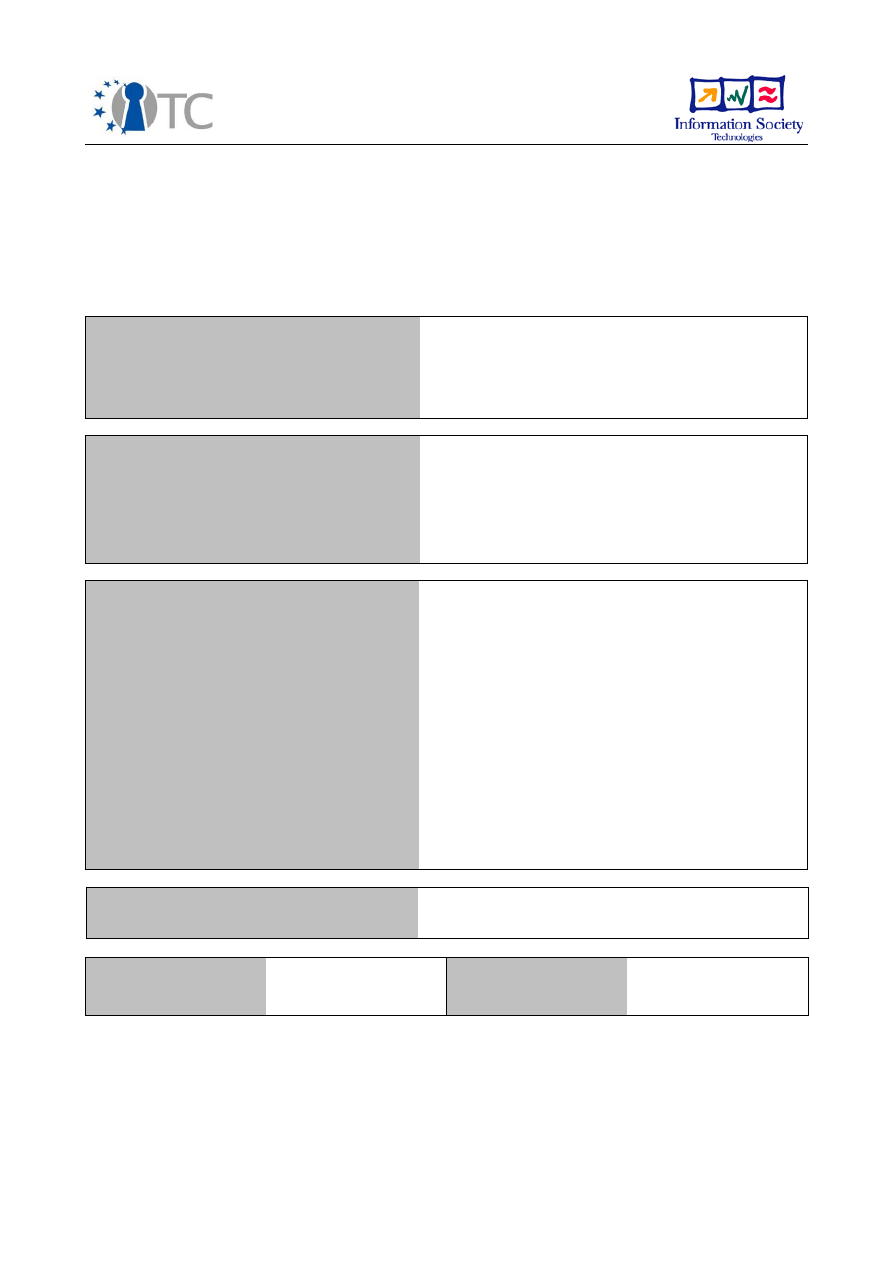
D06e.1 MFA Requirements and Specification
Project number
IST-027635
Project acronym
Open_TC
Project title
Open Trusted Computing
Deliverable type
Internal deliverable
Deliverable reference number
IST-027635/D06e.1/FINAL | 1.00
Deliverable title
MFA Requirements and Specification
WP contributing to the deliverable
WP06e.1
Due date
Apr 2006 - M06
Actual submission date
Sept 12, 2006
Responsible Organisation
INTEK
Authors
Irina Beliakova, Vladimir Bashmakov
Abstract
The goal of this application is to demonstrate
the secure access to remote server that in
addition to “what-you-know” information
(password) requires the platform
authentication through the use of TPM
Keywords
MFA, OPEN_TC, TPM
Dissemination level
Public
Revision
FINAL | 1.00
Instrument
IP
Start date of the
project
1
st
November 2005
Thematic Priority
IST
Duration
42 months

MFA Requirements and Specification
FINAL | 1.00
Table of Contents
1 Introduction ........................................................................................................... 5
2 Threat analysis........................................................................................................ 5
3 Functional requirements......................................................................................... 7
3.1 Roles and Actors................................................................................................ 7
3.2 Use cases........................................................................................................... 8
3.2.1 Client/server Installation of MFA components................................................ 8
3.2.2 Client Initialization.......................................................................................... 10
3.2.3 Platform registration....................................................................................... 11
3.2.4 Platform unregistration................................................................................... 12
3.2.5 User Registration............................................................................................ 13
3.2.6 Client logon.................................................................................................... 14
3.2.7 Client logoff.................................................................................................... 15
3.2.8 User/platform authentication.......................................................................... 16
3.2.9 Using a remote server secure application/service.......................................... 17
3.2.10 Server policy configuration........................................................................... 18
3.2.11 Platform registration on the server...............................................................19
3.2.12 Server logon session.................................................................................... 20
4 High level design................................................................................................. 21
4.1 Client operations.............................................................................................. 21
4.2 Server functionality.......................................................................................... 21
4.3 MFA system architecture................................................................................ 23
5 Required services from sublayers......................................................................... 24
6 Environment requirements ................................................................................. 24
7 Platform requirements......................................................................................... 25
8 List of abbreviations.............................................................................................. 25
9 Referenced Documents......................................................................................... 25
Open_TC Deliverable 06e.1
2/25

MFA Requirements and Specification
FINAL | 1.00
List of figures
Figure 1: MFA system architecture........................................................................... 22
Open_TC Deliverable 06e.1
3/25

MFA Requirements and Specification
FINAL | 1.00
1 Introduction
The TPM MultiFactor Authentication (MFA) system is an application of the Trusted
Computing technology and shows the benefits of such technology for ensuring that
only a user who owns a registered platform equipped with a TPM may have access to
the remote computer resources.
As long as an authorized system is used to access corporate resources, the entire
infrastructure can be thought of as protected. Even if somebody's credentials have
been stolen, the intruder will have to operate from a trusted corporate platform to gain
the access to the resources.
The multifactor authentication, including both the user and TPM-based platform
authentication, covers up these threats. The access to the network is granted only if
both elements - user and platform - are successfully authenticated.
This document contains the MFA requirements and high level architecture specification
for a preliminary release of the MFA system.
2 Threat analysis
Different threat types could be categorized by the general attacker goal:
●
Spoofing
.
Spoofing
is the attempt to gain access to a system by using a false
identity. This can be accomplished by using stolen user credentials or a false IP
address. After the attacker successfully gains access as a legitimate user or
host, the elevation of privileges or abuse using authorization can begin.
●
Tampering
.
Tampering
is the unauthorized modification of data, for example as
it flows over a network between two computers.
●
Repudiation
.
Repudiation
is the ability of users (legitimate or otherwise) to
deny that they performed specific actions or transactions. Without adequate
auditing, the repudiation attacks are difficult to prove.
●
Information disclosure
.
Information disclosure
is the unwanted exposure of
private data. For example, a user views the contents of a table or file he or she
is not authorized to open or monitors data passed in a plain text over a network.
Some examples of information disclosure vulnerabilities include the use of
hidden form fields, comments embedded in Web pages that contain database
connection strings and connection details and weak exception handling that can
lead to internal system level details being revealed to the client. Any of this
information can be very useful to the attacker.
●
Denial of service
.
Denial of service
is the process of making a system or
application unavailable. For example, a denial of service attack might be
accomplished by bombarding a server with requests to consume all available
system resources or by passing it malformed input data that can make an
application process crash.
●
Elevation of privilege
.
Elevation of privilege
occurs when a user with limited
privileges assumes the identity of a privileged user to gain privileged access to
an application. For example, an attacker with limited privileges might elevate
his or her privilege level to compromise and take control of a highly privileged
and trusted process or account.
Open_TC Deliverable 06e.1
4/25

MFA Requirements and Specification
FINAL | 1.00
Each threat category has a corresponding set of countermeasure techniques that
should be used to reduce the risk of attacks. These countermeasures are summarized
in the following table:
Threat
Typical Countermeasures
Spoofing the
user identity
●
Use strong authentication
●
Do not store secrets in plain text
●
Do not pass credentials in plain text over the wire
authentication
●
Protect authentication cookies with Secure Sockets Layer
(SSL)
Tampering with
data
●
Use data hashing and signing
●
Use digital signatures
●
Use strong authorization
●
Use tamper-resistant protocols across communication links
●
Secure communication links with protocols that provide
message integrity
Repudiation
●
Create secure audit trails
●
Use digital signatures
Information
disclosure
●
Use strong authorization
●
Use strong encryption
●
Secure communication links with protocols that provide
message confidentiality
●
Do not store secrets (for example, passwords) in plain text
Denial of service
●
Use resource and bandwidth throttling techniques
●
Validate and filter input
Elevation of
privilege
●
Follow the principle of least privilege
●
Use least privileged service accounts to run processes and
access resources
Open_TC Deliverable 06e.1
5/25

MFA Requirements and Specification
FINAL | 1.00
3 Functional requirements
3.1 Roles and Actors
●
User:
the entity that performs the requests for using the remote services and
wants to be authenticated. In some scenarios the user and the administrator
may be the same person.
●
Administrator:
the system administrator on the server/client side installs the
software and performs all system operations.
●
Authentication:
in computer security authentication is the process of
attempting to verify the identity of the sender of a communication such as a
request to log in. The sender being authenticated may be a person.
●
MFA:
Multifactor Authentication. The general idea of a MFA architecture is to
use several types of credentials to authenticate the user during the logon to
remote server computers in order to enforce a strong authentication security. In
our case MFA is two-factor authentication system: user identity and TPM-
equipped platform identity.
●
Login:
login is the process of receiving access to a computer system
by
identification of the user in order to obtain credential to permit access. It is an
integral part of computer security procedure. Logon to system with multifactor
authentication uses two credentials: user password and TPM-equipped platform
identity to permit access to resources.
Open_TC Deliverable 06e.1
6/25
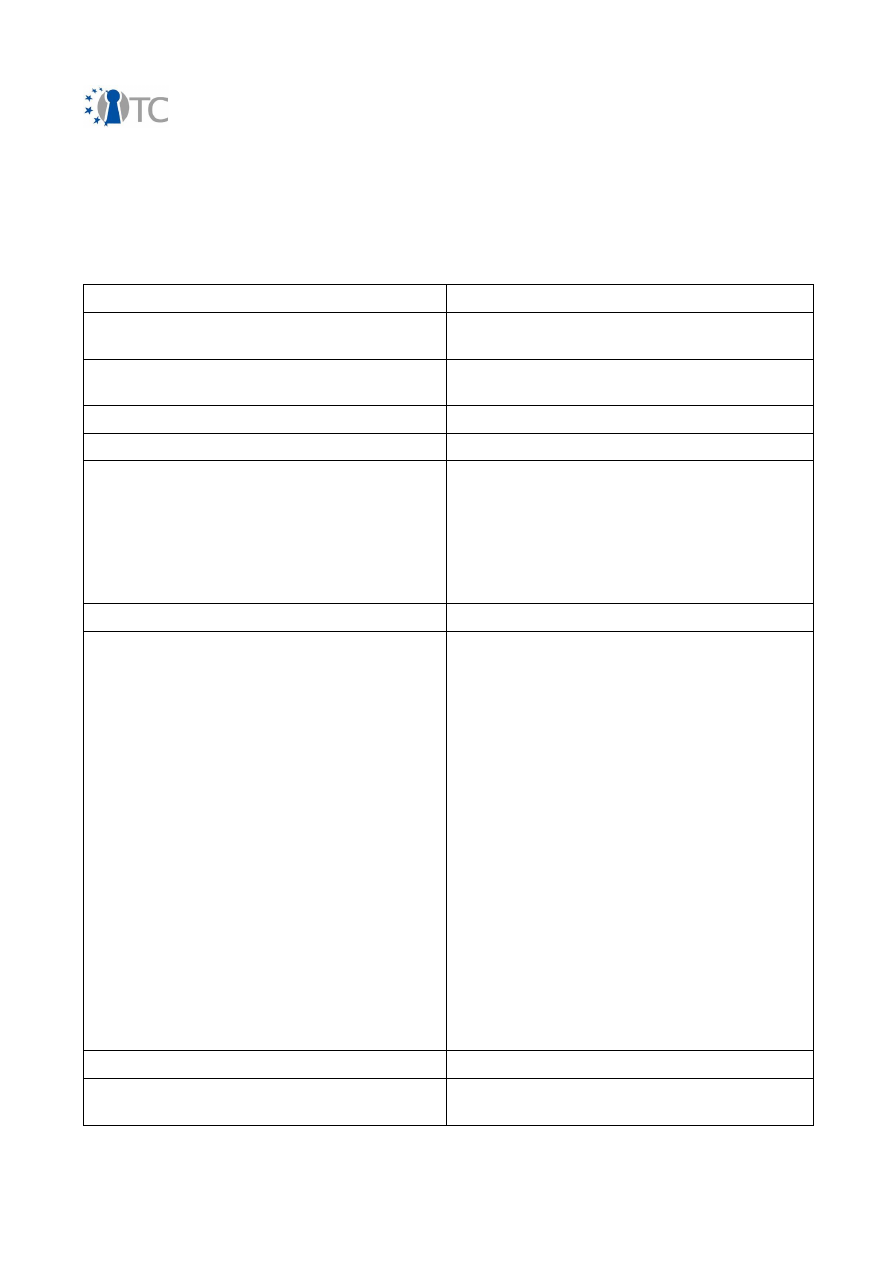
MFA Requirements and Specification
FINAL | 1.00
3.2 Use cases
3.2.1 Client/server Installation of MFA components
Use case unique ID
/UC 10/
Title
Client/server Installation of MFA
components
Authors
Irina Beliakova, Vladimir Bashmakov
(INTEK)
Use case revision number
01
Use case revision date
2006-11-15
Short description/purpose(s)
The client and server components are
installed on two systems by the system
administrator. After the installation is
completed the user has access to the
client computer components and the
system administrator has access to server
computer components.
Roles
Administrator
Includes
●
An installed and running Open_TC
framework on the client and server
platform.
●
Multifactor authentication services
require fully a implemented Trusted
Software Stack (TSS) for Linux
according to TCG specification. TSS
stack must support basic TCG
functionality including the
generation of Attestation Identities
Keys (AIK), extending and retrieving
the values of the TPM Platform
Configuration Registers (PCRs).
●
The security services such as
OpenSSL.
●
Crypto/PKI services.
●
OpenTC Certificate Authority (CA) to
provide the cryptographic certificate
infrastructure.
Preconditions
(none)
Postcondition
The demo applications of the OTC security
architecture can be used.
Open_TC Deliverable 06e.1
7/25

MFA Requirements and Specification
FINAL | 1.00
Normal Flow
The administrator executes and completes
the installation procedure.
Open_TC Deliverable 06e.1
8/25
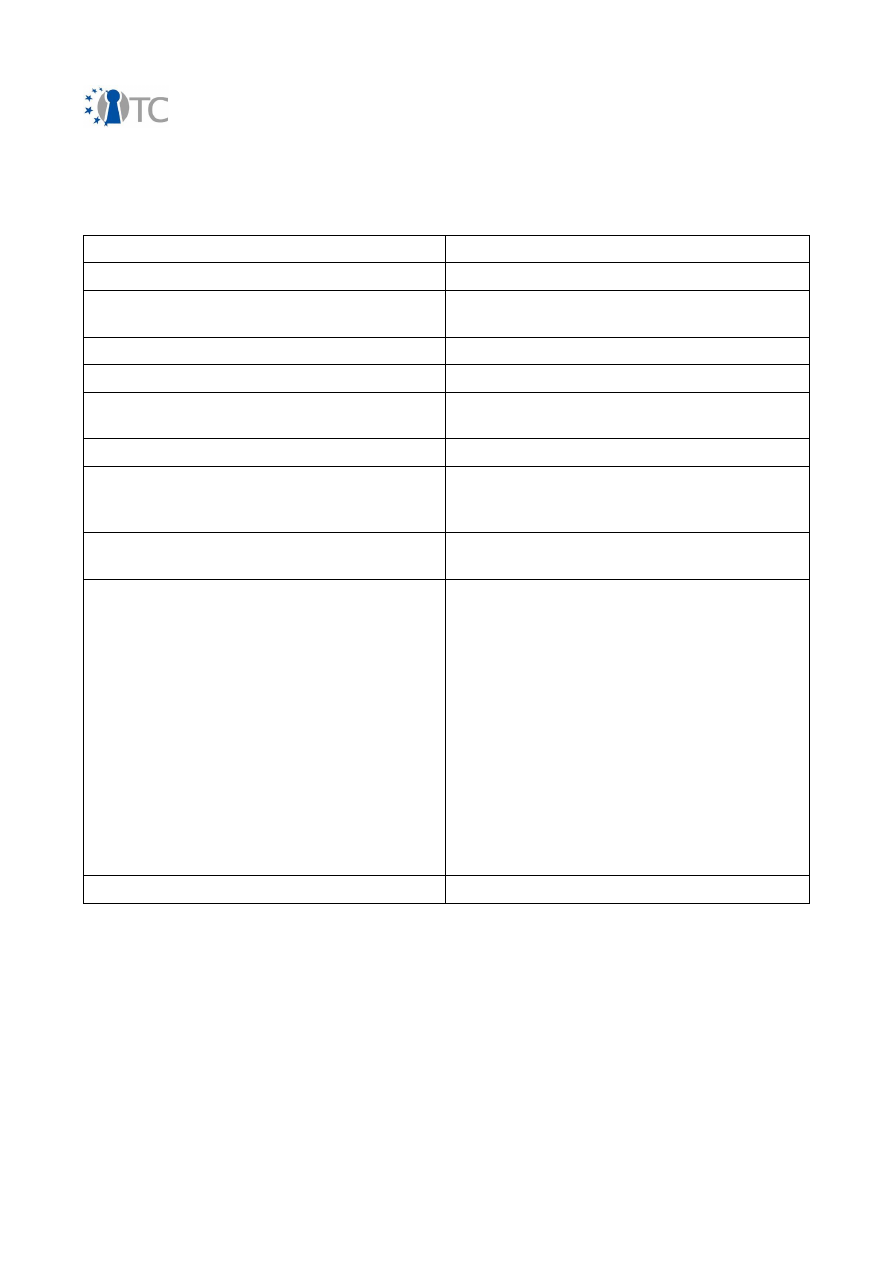
MFA Requirements and Specification
FINAL | 1.00
3.2.2 Client Initialization
Use case unique ID
/UC 100/
Title
Client initialization
Authors
Irina Beliakova, Vladimir Bashmakov
(INTEK)
Use case revision number
01
Use case revision date
2006-01-16
Short description/purpose(s)
The administrator starts the utility to
initialize the TPM and create an AIK.
Roles
Administrator
Preconditions
This TPM platform has not been initialized
before; UC 10 should be done before this
action.
Postcondition
Initialized platform can be used to log on
into the remote server.
Normal Flow
1. The authorized administrator
invokes the initialize utility
to take the TPM ownership.
2. An AIK is created inside the local
repository.
3. A request for an AIK certificate is
built and sent to the OpenTC
Privacy CA.
4. The AIK is activated and the AIK
certificate is being retrieved.
5. OpenTC Privacy CA holds the copy
of this certificate for the
authentication purposes, and the
platform as the unique identifier.
Open_TC Deliverable 06e.1
9/25

MFA Requirements and Specification
FINAL | 1.00
3.2.3 Platform registration
Use case unique ID
/UC 110/
Title
Platform registration
Authors
Irina Beliakova, Vladimir Bashmakov
(INTEK)
Use case revision number
01
Use case revision date
2006-01-16
Short description/purpose(s)
The administrator registers the TPM-
equipped platform with remote server.
Rationale
In a physically separated environment
this is similar to registering a computing
platform from a network.
Roles
Administrator (client/server)
Preconditions
UC 100 should be done before this action
Postcondition
User from the client trusted platform can
remote log on to the server
Normal Flow
1. The administrator invokes the
platform registration utility.
2. The system authenticates the
administrator.
3. The administrator selects the
server to register to.
4. The system registers the TPM
platform credentials, created in UC
100, with selected remote server.
Open_TC Deliverable 06e.1
10/25
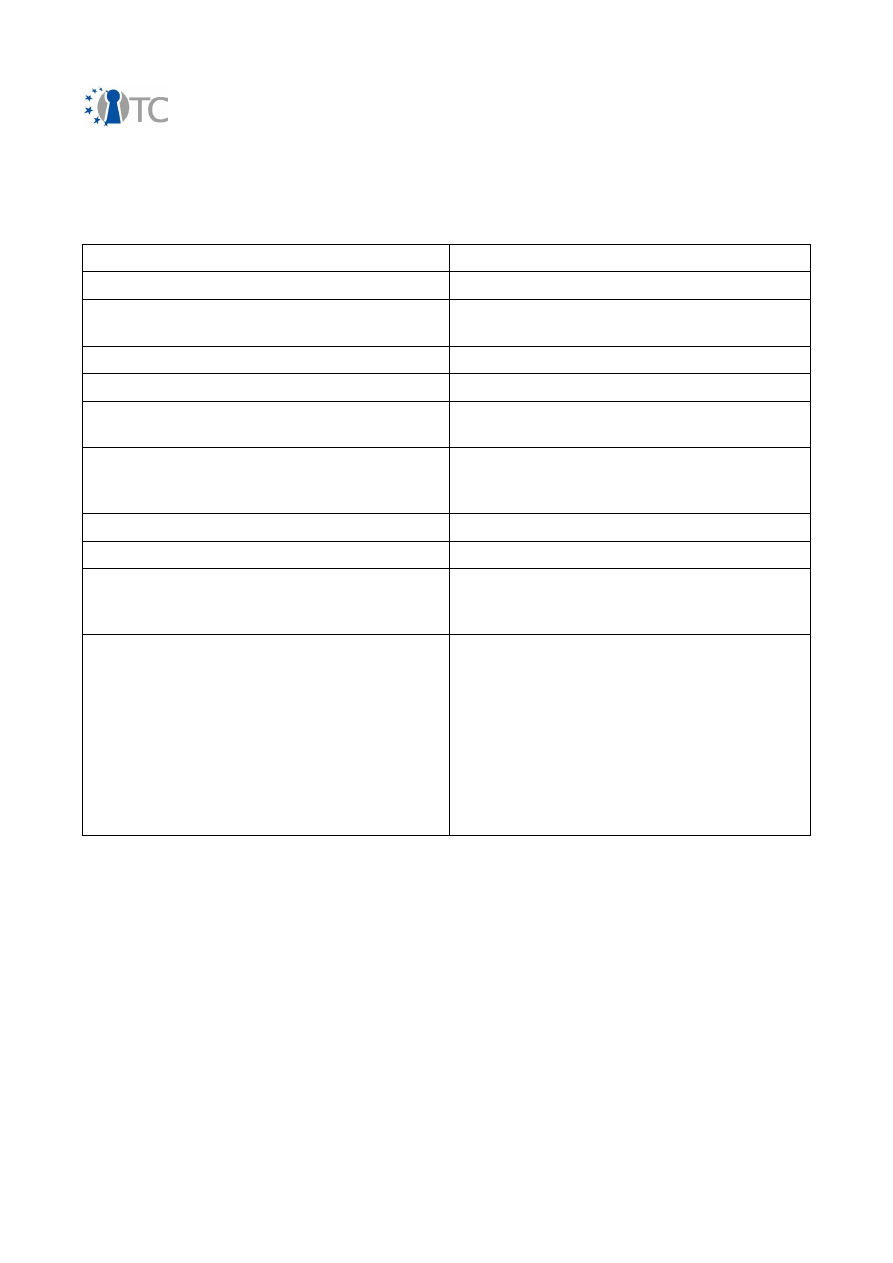
MFA Requirements and Specification
FINAL | 1.00
3.2.4 Platform unregistration
Use case unique ID
/UC 120/
Title
Platform unregistration
Authors
Irina Beliakova, Vladimir Bashmakov
(INTEK)
Use case revision number
01
Use case revision date
2006-01-16
Short description/purpose(s)
The administrator unregisters the TPM-
equipped platform with remote server.
Rationale
In a physically separated environment
this is similar to unregistering a
computing platform from a network.
Roles
Administrator (client/server)
Preconditions
UC 110 has been done before this action
Postcondition
User from the client trusted platform
cannot remote log on anymore to the
server
Normal Flow
5. The administrator invokes the
platform unregistration utility.
6. The system authenticates the
administrator.
7. The administrator selects the
server to register to.
8. The system unregisters the TPM
platform credentials, registered in
UC 110, with selected remote
server.
Open_TC Deliverable 06e.1
11/25

MFA Requirements and Specification
FINAL | 1.00
3.2.5 User Registration
The possibility of a new user registration relies solely on the existing infrastructure on
the client and remote server. The MFA system does not intend to interfere in any way
the security practices existing in the infrastructure.
On the server the user rights and access policy are controlled by the operational
system.
Open_TC Deliverable 06e.1
12/25
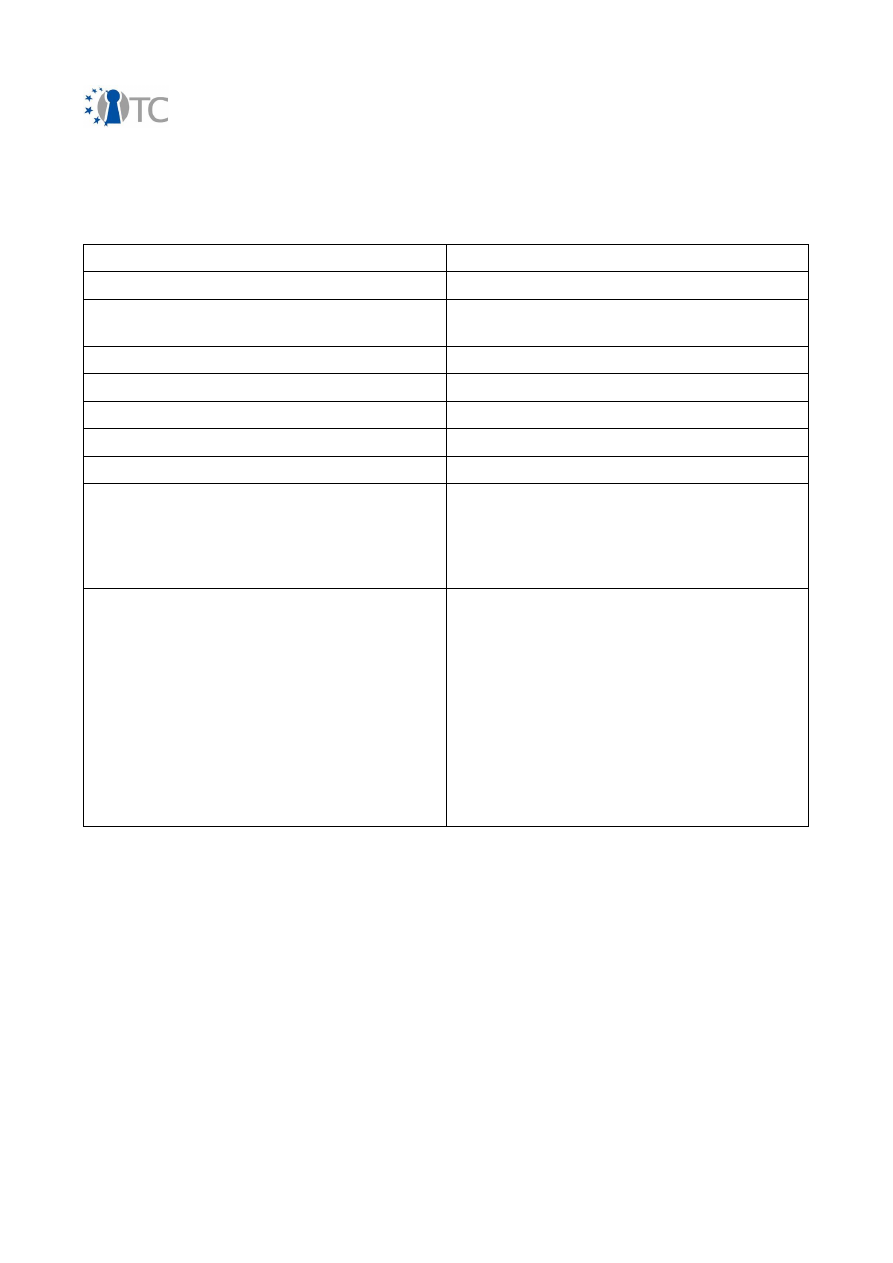
MFA Requirements and Specification
FINAL | 1.00
3.2.6 Client logon
Use case unique ID
/UC 200/
Title
Client logon
Authors
Irina Beliakova, Vladimir Bashmakov
(INTEK)
Use case revision number
01
Use case revision date
2006-01-16
Short description/purpose(s)
The user wishes to use a remote service.
Roles
User
Includes
/UC 220/ User Authentication
Preconditions
1. The client user is going to log on
from the client computer already
registered.
2. /UC 400/ should be done before this
action
Normal Flow
1. The user
notifies the local system
(client) that s/he wishes to use a
service running in a remote
computer.
2. The user enters the user name and
name or address of the remote
server running the wanted service.
3. According to the security policy the
remote system authenticates the
user (see /UC 220/).
4. A session with the remote service is
started.
Open_TC Deliverable 06e.1
13/25

MFA Requirements and Specification
FINAL | 1.00
3.2.7 Client logoff
Use case unique ID
/UC 210/
Title
Client logoff
Authors
Irina Beliakova, Vladimir Bashmakov
Use case revision number
01
Use case revision date
2006-01-16
Short description/purpose(s)
The user wishes to end current working
session with the remote server.
Roles
User
Includes
(none)
Preconditions
The user has already started a session
with the server (see /UC 200/).
Postcondition
The user cannot use the server anymore
without performing a new logon session.
Normal Flow
1. The user notifies the local system
(client) that s/he wishes to end a
session.
2. The user will be disconnected from
the server.
Open_TC Deliverable 06e.1
14/25

MFA Requirements and Specification
FINAL | 1.00
3.2.8 User/platform authentication
Use case unique ID (per WP or SWP)
/UC 220/
Title
User/platform authentication
Authors
Irina Beliakova. Vladimir Bashmakov
(INTEK)
Use case revision number
01
Use case revision date
2006-01-16
Short description/purpose(s)
The client asks the remote server to
authenticate the user/TPM-equipped
platform according to the policy set for
the user
Roles
User
Includes
(none)
Preconditions
/UC 400/ should be done before this
action.
Normal Flow
1. The system asks the user for
authentication data.
2. The user enters data.
3. The remote system authenticates
the user and TPM-equipped
platform.
Open_TC Deliverable 06e.1
15/25

MFA Requirements and Specification
FINAL | 1.00
3.2.9 Using a remote server secure application/service
Use case unique ID
/UC 300/
Title
Using a remote server secure
application/service
Authors
Irina Beliakova, Vladimir Bashmakov
(INTEK)
Use case revision number
01
Use case revision date
2006-01-16
Short description/purpose(s)
The user starts a session with the remote
secure application/service
Roles
User
Includes
/UC 200/ Client logon
/UC 210/ Client logoff
Preconditions
1. /UC 110/ should be done before this
action.
2. /UC 400/ should be done before this
action.
Normal Flow
1. The user notifies the system that
s/he wishes to start a logon session.
2. The system opens a new logon to
application session (see /UC 200/).
3. The user works with the application
4. The user closes the application
session (see /UC 210/).
5. The user-interface of the
application disappears.
Open_TC Deliverable 06e.1
16/25

MFA Requirements and Specification
FINAL | 1.00
3.2.10 Server policy configuration
Use case unique ID
/UC 400/
Title
Server policy configuration
Authors
Irina Beliakova, Vladimir Bashmakov
(INTEK)
Use case revision number
01
Use case revision date
2006-01-16
Short description/purpose(s)
The administrator starts the utility to
configure the user logon and policy
setting.
Roles
Administrator
Preconditions
/UC 10/ and /UC 100/ should be done
before this action.
Postcondition
The user from the trusted client can log on
to the remote server using the TPM-
equipped platform identity .
Normal Flow
1. The authorized administrator
invokes the Credential and Policy
manager to set access right for
logon for list of users.
2. The administrator set the policy
allow to log on by verifying the user
password or / and TPM-equipped
platform identity.
Open_TC Deliverable 06e.1
17/25

MFA Requirements and Specification
FINAL | 1.00
3.2.11 Platform registration on the server
Use case unique ID
/UC 410/
Title
Platform registration on the server
Authors
Irina Beliakova, Vladimir Bashmakov
(INTEK)
Use case revision number
01
Use case revision date
2006-01-16
Short description/purpose(s)
The server registers the TPM-equipped
platform. The server accepts the TPM
credentials from clients and saves them
in the Master Repository.
Rationale
In a physically separated environment,
this is similar to registering a computing
platform from a network.
Roles
Administrator
Preconditions
/UC 100/ should be done before
Postcondition
Server can be used for remote MFA
access.
Normal Flow
1. This use case is triggered /UC 110/
2. The server invokes the register
service.
3. The system authenticates the
administrator.
4. The register service saves TPM
credential in Master Repository.
Open_TC Deliverable 06e.1
18/25

MFA Requirements and Specification
FINAL | 1.00
3.2.12 Server logon session
Use case unique ID
/UC 510/
Title
Server logon session
Authors
Irina Beliakova, Vladimir Bashmakov
(INTEK)
Use case revision number
01
Use case revision date
2006-01-16
Short description/purpose(s)
After TPM client logon is successful the
user have access to remote server
resources according user permissions
Roles
User
Includes
Preconditions
The client user is going to logon from the
computer already registered
.
1. /UC 110/ should be done before .
2. /UC 400/ should be done before
Normal Flow
1. Server user logon session starts
2. Authentication server requests the
user, TPM credentials.
3. According to the security policy the
remote system authenticates the
user and TPM platform (see /UC
320/).
Open_TC Deliverable 06e.1
19/25

MFA Requirements and Specification
FINAL | 1.00
4 High level design
The design and implementation of the MFA system has a goal to prevent the listed
threat by using as countermeasure technique the TPM-equipped platform identity for
trusted remote access to server.
The multifactor authentication, including both user and platform authentication, covers
up most of these threats. The access to the network is granted only if both elements -
user and platform - are successfully authenticated.
Multifactor authentication to remote server should include components executed at
server and client computers. Client components register the trusted platform with the
remote server. Client components use the TSS at interface to the local TPM. A user can
login to a remote server once the platform registration is completed.
The parameters of multifactor authentication system should be controlled by
authentication policies configured on the remote platform.
4.1 Client operations
1.
Platform registration with the remote server.
An existing user with administrative rights can register the platform
authentication information, namely the AIK and PCR's.
The AIK is created inside the local TPM, the AIK certificate request is built and
sent to the Open_TC Privacy CA. PCRs are extended during the bootstrap with
the integrity measurements client computer software. The credentials are saved
on the remote server.
2. Standard user registration with remote server using the preexisting
infrastructure.
3.
Logon to the remote server.
The Logon Application (LAP) establishes secure communication channel with a
remote server using OpenSSL or other secure channel. The LAP then retrieves
the TPM Platform Configuration Registers (PCRs) values, platform AIK, and
collects the User Identity (UI). PCRs and Challenge are signed with the platform
AIK to ensure the information security. This authentication information is being
sent to the remote server for authentication.
The server queries the Open_TC Privacy Certificate Authority (CA) to certify the
platform AIK. Then it verifies TPM PCRs. If both steps succeed, the server
proceeds with user authentication, which relies on the existing authentication
infrastructure and is out of the scope of this scenario.
4.2 Server functionality
1.
Register the platform and store platform information.
The server supports the platform registration. This procedure involves
registering platform AIK certificate and PCR's.
2.
Register the user and store user information.
The server can verify user credentials. This basically relies on the existing
authentication infrastructure.
Open_TC Deliverable 06e.1
20/25

MFA Requirements and Specification
FINAL | 1.00
3.
Edit user/platform policy for multifactor access.
The system administrator can change the user policies on the server to
determine the required credentials in order to log on to the server.
4.
Enforce policy for server access.
The server can verify user credentials with defined policy set and reject logon if
the multifactor authentication fails.
Open_TC Deliverable 06e.1
21/25
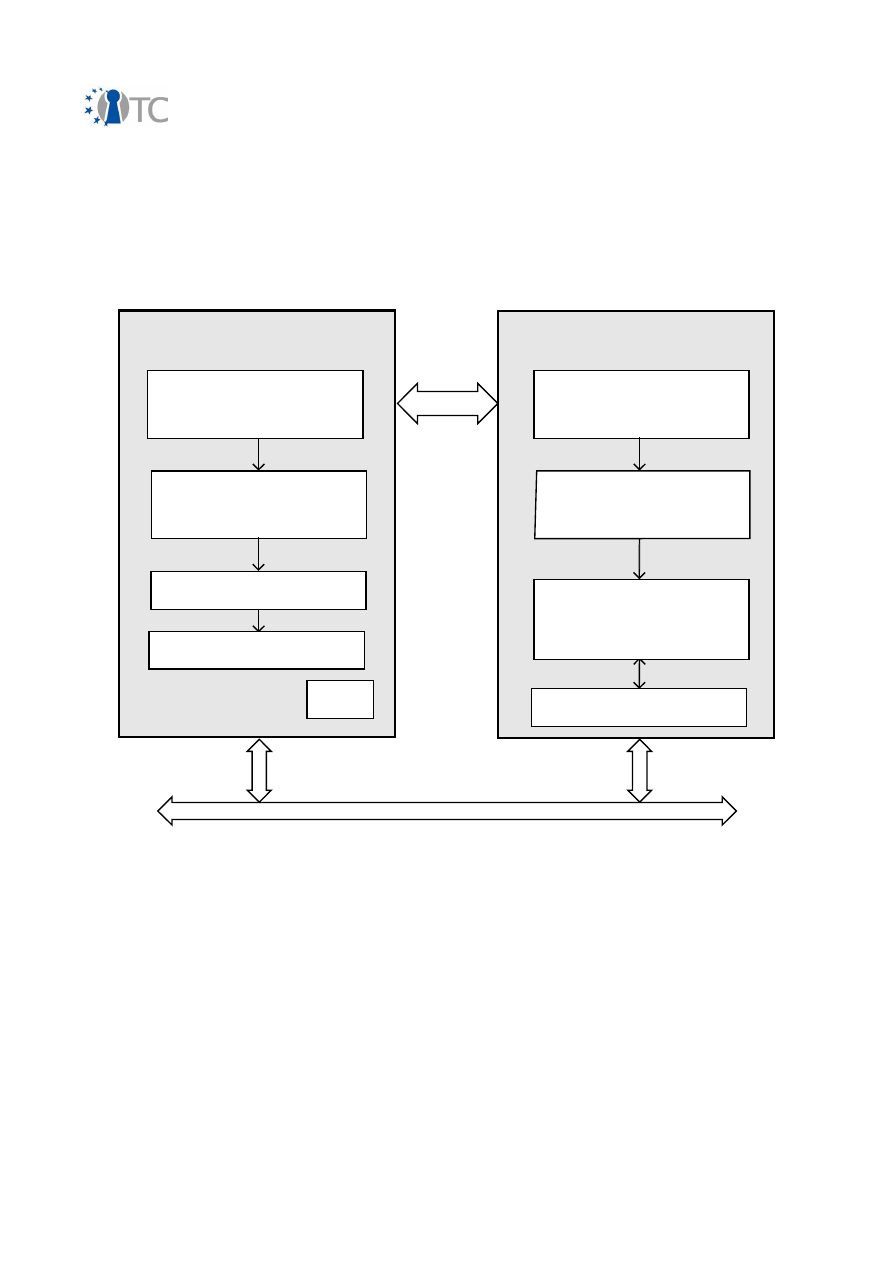
MFA Requirements and Specification
FINAL | 1.00
4.3 MFA system architecture
A preliminary MFA system architecture is depicted in figure 1 and the components are:
●
OpenTC framework.
Open Trusted Computing framework
includes a
virtualization layer
that is managing multiple compartments and security
services on the client.
●
Client.
Client
is a computer system that accesses a (remote) service on another
computer by some kind of network. For everyday tasks such as word processing,
surfing the Internet or image processing the user is working with his well known,
general purpose operating system. This operating system could run on top of a
hypervisor in parallel to other compartments and security services.
●
Server.
Server
is a computer system that provides services to other computing
systems
(clients). The entity the user wants to use to do some computer works.
Open_TC Deliverable 06e.1
22/25
Figure 1: MFA system architecture
Trusted Compartment
Client Computer
Server Computer
MFA Logon application
VM Trusted & TPM
management
Linux OS
Virtualization Layer
TPM
Remote Computer
Authentication &
Registration Server
MFA Credential & Policy
Manager
Master Repository
User & TPM & Settings
DataBase
Linux OS
Secure channel
Logon
Client Computer

MFA Requirements and Specification
FINAL | 1.00
The server defines the policy whether a connecting client user machine is to be
considered “trusted” or not.
●
Credential & Policy manager.
The credential & policy manager
is responsible
to manage and store the user's credentials & policies. The credentials used
when authenticating the user with the remote server. The credential manager
ensures that these credentials are securely stored. Secure
Master Repository
is used to save and keep the secure data. MFA includes administrative
functionality to configure authentication methods and access rights and
settings.
●
TPM.
Trusted Platform Module
is
a chip that provides Trusted Computing
features.
●
PCR.
Platform Configuration Registers
. TPM volatile memory section contains
platform configuration registers. These registers contain the integrity
measurements (hashes) of the firmware and loaded software. During the system
boot the BIOS, the BIOS extensions, MBR, the boot loader (namely GRUB) stages
are measured and any designated files, such as the kernel. These
measurements are used to extend the various PCRs.
●
Client components.
MFA
components installed on the client.
●
Remote server components.
MFA
components installed on the remote
server.
The client and server components are installed on two systems by the system
administrator. After the installation has been completed the user has access to
the client system. The system administrator has access to server computer.
Since the specification of the services and interfaces provided by the OpenTC
framework are currently an ongoing work, the details of the interactions among MFA
and such services will be specified in the final MFA specifications.
5 Required services from sublayers
●
An installed and running Open_TC framework on the client platform.
●
Multifactor authentication services require fully implemented Trusted Software
Stack (TSS) for Linux according to TCG specification. TSS stack must support
basic TCG functionality including Attestation Identities Keys (AIK) generation,
TPM Platform Configuration Registers (PCRs) management.
●
The security services such as OpenSSL for Open_TC will be used.
●
Crypto/PKI services - from SWP03c.
●
Open_TC Certificate Authority (CA) to provide the cryptographic certificate
infrastructure.
6 Environment requirements
●
A linux distribution (Fedora 5, OpenSUSE 10 or Damn Small Linux)
●
PAM Framework
Open_TC Deliverable 06e.1
23/25
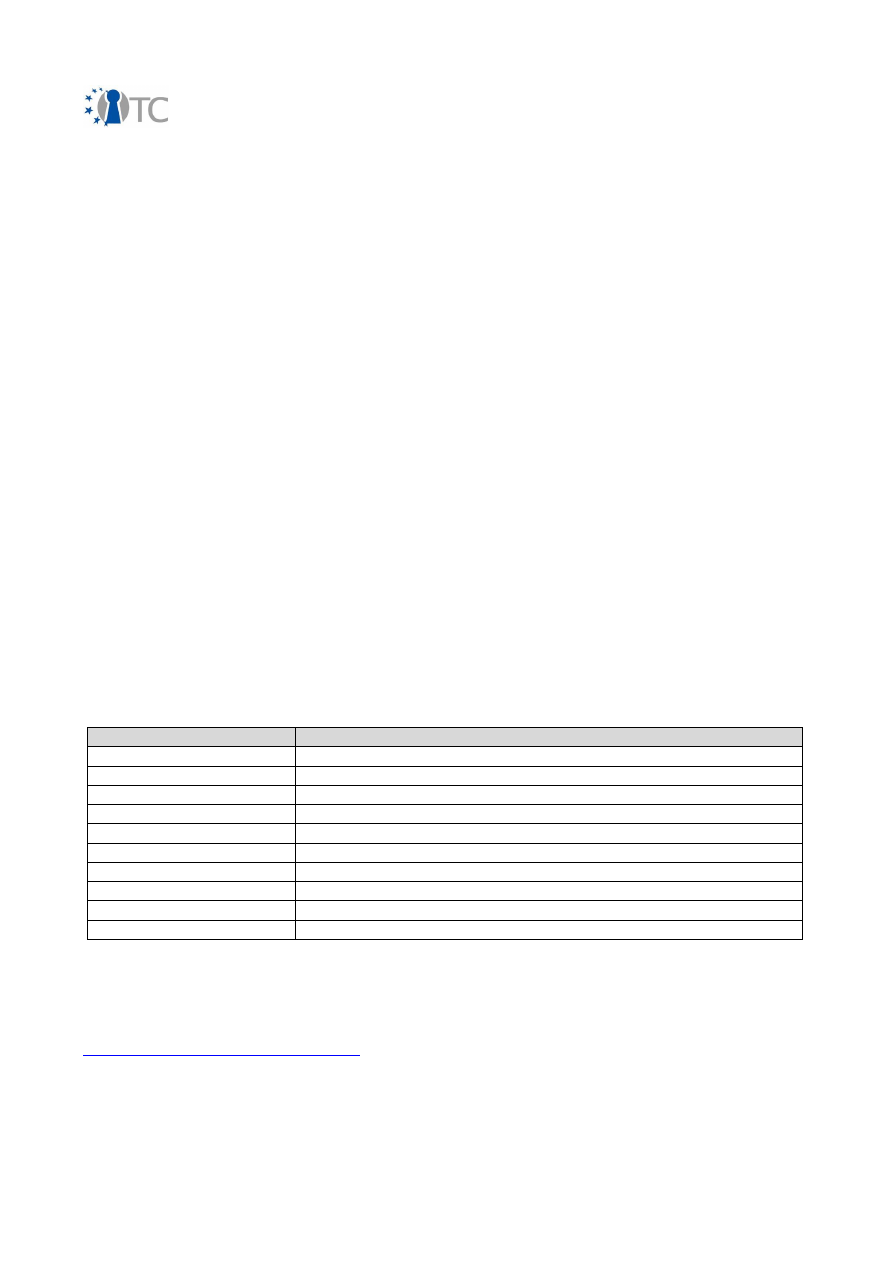
MFA Requirements and Specification
FINAL | 1.00
●
OpenSSL Library
●
TSS 1.2 library
●
TPM Tools 1.2.4
●
TSS Test Suite_27022006
●
Linux 2.6.x
●
gcc 3.4.x
●
eclipse-3.1
7 Platform requirements
The Product is compatible with standard Linux environment with TPM platform installed
and initialized.
The MFA system Product supports features and functionality enabled by a Trusted
Platform Module (TPM) that requires the following components to be installed:
●
Infineon TPM SLD 9630 TT 1.1b with TPM firmware 1.05 or higher; Infineon
provides a firmware update via a tool based on the TCG field upgrade approach
that will be deployed by means comparable to driver updates.
●
TPM TestSuite –27022006 IBM
●
TPM driver and TSS.
8 List of abbreviations
Listing of term definitions and abbreviations used in this document (IT expressions and
terms from the application domain).
Abbreviation
Explanation
AIK
Attestation Identity Key
MFA
MultiFactor Authentication
OS
Operating System
PCR
Platform Configuration Register
SSL
Secure Sockets Layer
TC
Trusted Computing
TCB
Trusted Computing Base
TCG
Trusted Computing Group
TPM
Trusted Platform Module
TSS
Trusted Software Stack
9 Referenced Documents
/1/ TCG Specification, Architecture Overview.
http://www.trustedcomputing.org
April 28, 2004,
Version 1.2
/2/ TCG Software Stack (TSS) Specification
Open_TC Deliverable 06e.1
24/25

MFA Requirements and Specification
FINAL | 1.00
January 6, 2006,
Version 1.2
/3/ PAM
http://www.kernel.org/pub/linux/libs/pam/Linux-PAM-html/Linux-
PAM_ADG.html
http://msdn.microsoft.com
Version 0.99.6.0, 5. August 2006.
/4/ Secure Coding Guidelines
http://msdn.microsoft.com
2004
/5/ Improving Web Application Security: Threats and Countermeasures
http://msdn.microsoft.com
/6/ Writing Secure Code, Second Edition, by Michael Howard, David C. LeBlanc
/7/ OpenSSL Toolkit
www.openssl.org/
Open_TC Deliverable 06e.1
25/25
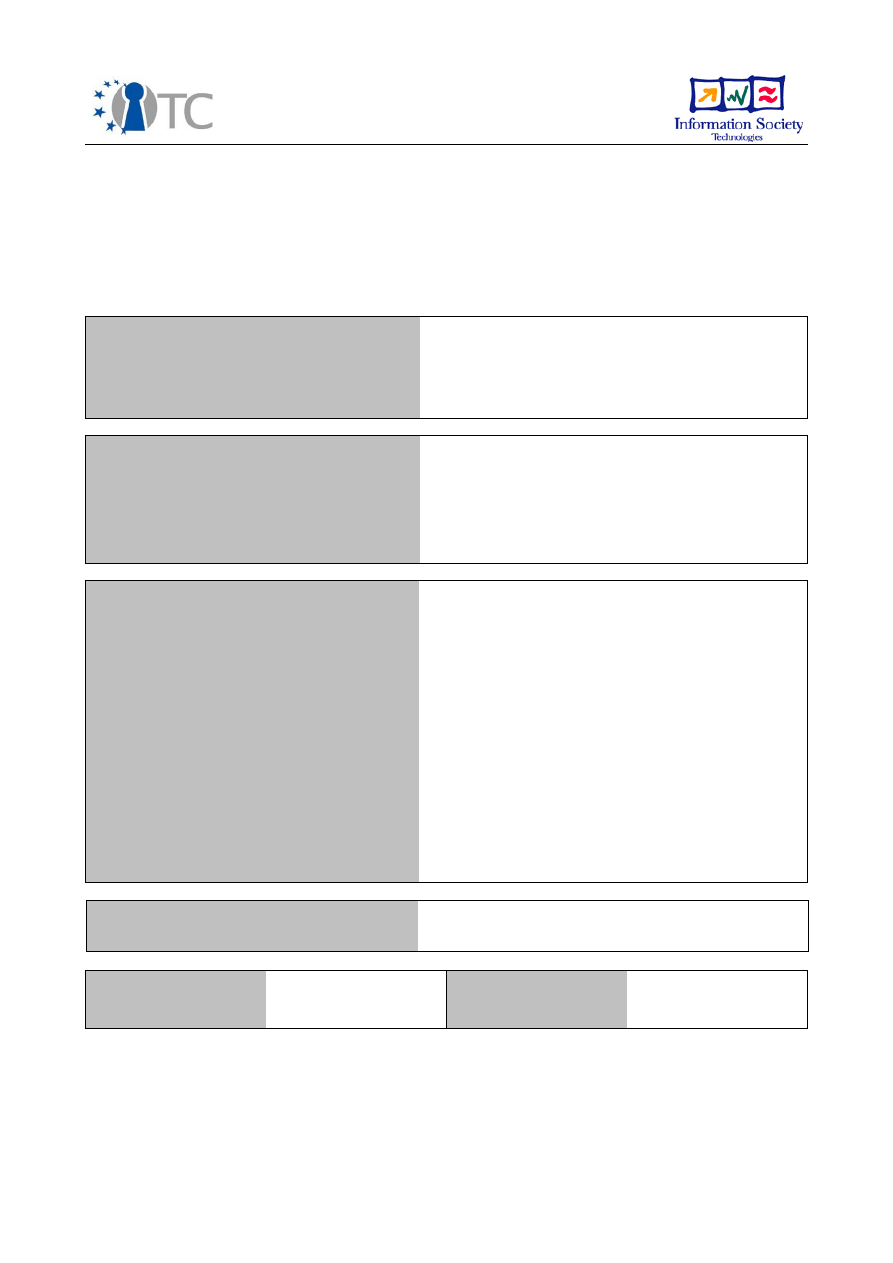
D6e.3: Intermediate MFA System Specification
Project number
IST-027635
Project acronym
Open_TC
Project title
Open Trusted Computing
Deliverable type
Internal Report
Deliverable reference number
IST-027635/D6e.3/PUBLIC | 1.00
Deliverable title
MFA Concept Prototype
WP contributing to the deliverable
WP6
Due date
Aug 2006 - M08
Actual submission date
Sept 12,2006
Responsible Organisation
INTEK
Authors
Irina Beliakova, Vladimir Tsisser
Abstract
This document describes MFA System which
use trusted platform features for a secure,
multifactor authentication to remote
computers. System allows to make remote
logon by using TPM credentials and/or
password. The document contains system
architecture, components, their interactions.
Keywords
PAM, TPM, Credential Manager, MFA
Dissemination level
Public
Revision
PUBLIC | 1.00
Instrument
IP
Start date of the
project
1
st
November 2005
Thematic Priority
IST
Duration
42 months

MFA Intermediate System Specification
PUBLIC | 1.00
Table of Contents
1 Introduction............................................................................................................... 4
2 Requirements breakdown.......................................................................................... 4
3 High level design specification................................................................................... 4
4 Functionality.............................................................................................................. 6
4.1 Actions................................................................................................................... 6
4.2 Policies................................................................................................................... 8
4.3 Data structure organization example..................................................................... 8
5 Preliminary MFA API................................................................................................... 9
5.1 Data Types............................................................................................................. 9
Pointer Size:........................................................................................................... 9
Basic T ypes:........................................................................................................... 9
Derived Types:....................................................................................................... 9
Common return code defines:.............................................................................. 10
5.2 Structures............................................................................................................. 10
5.2.1 MFA_VERSION................................................................................................. 10
5.2.1 MFA_CONTEXT_INFO ....................................................................................... 10
5.3 Interface definition............................................................................................... 11
5.3.1 mfa_Context_Create ....................................................................................... 11
5.3.2 mfa_Context_Close.......................................................................................... 11
5.3.3 mfa_Context_GetStatus .................................................................................. 12
5.3.4 mfa_Context_FreeMemory .............................................................................. 12
5.3.5 mfa_S_RegisterPlatform .................................................................................. 13
5.3.6 mfa_S_Authenticate......................................................................................... 13
5.3.7 mfa_S_SetAccessPolicy.................................................................................... 13
5.3.8 mfa_S_GetAccessPolicy....................................................................................14
5.3.9 mfa_Platform_Initialize .................................................................................... 14
5.3.1 0mfa_C_GetPlaformData.................................................................................. 14
6 List of abbreviations................................................................................................. 15
7 Referenced Documents............................................................................................ 15
Open_TC Deliverable 6e.3
2/16

MFA Intermediate System Specification
PUBLIC | 1.00
List of figures
Figure 1: MFA Components............................................................................................. 5
Figure 2: Platform registration........................................................................................ 6
Figure 3: Platform authentication................................................................................... 8
Open_TC Deliverable 6e.3
3/16

MFA Intermediate System Specification
PUBLIC | 1.00
1 Introducti
on
The TPM MultiFactor Authentication (MFA) system is an application of the Trusted
Computing technology and shows the benefits of such technology for ensuring that
only a user who owns a registered platform equipped with a TPM may have access to
the remote computer resources.
Multifactor authentication to remote server involves components executed at server
and client computers. Client components register TPM with the remote server. Client
components uses the local TPM through TSS. The user can login to a remote server
once the platform registration is completed.
The parameters of multifactor authentication system can be controlled by
authentication policies.
This document gives high level design specification of a MFA system: the components
protocol messages exchanged by the components and a preliminary API.
Since the specification of the services and interfaces provided by the OpenTC
framework are currently an ongoing work, the details of the interactions among MFA
and such services will be specified in the final MFA specifications.
2 Requirements breakdown
As long as an authorized system is used to access corporate resources, the entire
infrastructure can be thought of as protected. Even if somebody's credentials have
been stolen, the intruder will have to operate from a trusted corporate platform to
gain the access to the resources. On the other hand even the authorized user may
mistakenly try to gain the access from improperly configured system, such as home
computer, untrusted device, and etc. - the platforms that by definition are outside the
corporate control.
The multifactor authentication, including both user and platform authentication covers
up most of these threats. The access to the network is granted only if both elements -
user and platform - are successfully authenticated.
An installed and running Open_TC framework on the client platform is required.
Implementation of Multifactor Authentication application expects the presence of an
underlying trusted framework and requires the following services from it.
●
Trusted Software Stack (TSS) for Linux according to TCG specification. TSS stack
must support basic TCG functionality including Attestation Identities Keys (AIK)
generation, TPM Platform Configuration Registers (PCRs) calculation, storing,
and retrieval.
●
Security services such as OpenSSL to provide secure communication protocol.
●
Crypto and PKI services developed in SWP03c and SWP05d.
For a more comprehensive description of the MFA requirements, the reader should
refer to the deliverable: “D06e.1 MFA Requirements and Specification”.
3 High level design specification
The MFA architecture includes two components components types:
Open_TC Deliverable 6e.3
4/16
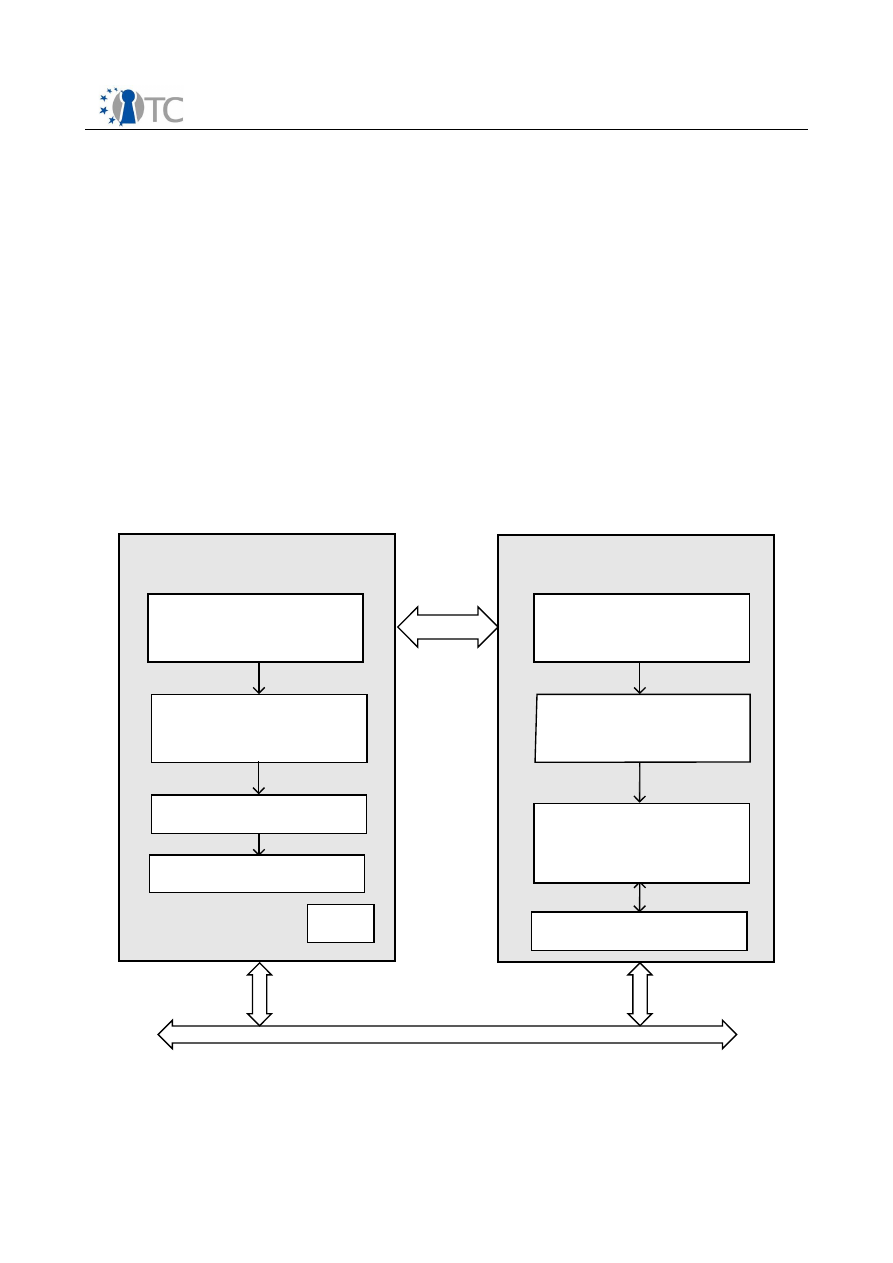
MFA Intermediate System Specification
PUBLIC | 1.00
1. Client components
Register credential utility
2. Remote server components:
Authentication and Registration Server
Platform/User identities database: Master Repository
Credential & Policy Manager
The client and server components are installed on two systems by the system
administrator. After installation is completed the user has access to the client system
and the system administrator has access to server computer.
These components can run on on a single Linux box with TSS and TPM as well as on
top of the Open_TC framework. (Fig.1)
Open_TC Deliverable 6e.3
5/16
Figure 1: MFA Components
Trusted Compartment
Client Computer
Server Computer
MFA Logon application
VM Trusted & TPM
management
Linux OS
Virtualization Layer
TPM
Remote Computer
Authentication &
Registration Server
MFA Credential & Policy
Manager
Master Repository
User & TPM & Settings
DataBase
Linux OS
Secure channel
Logon
Client Computer
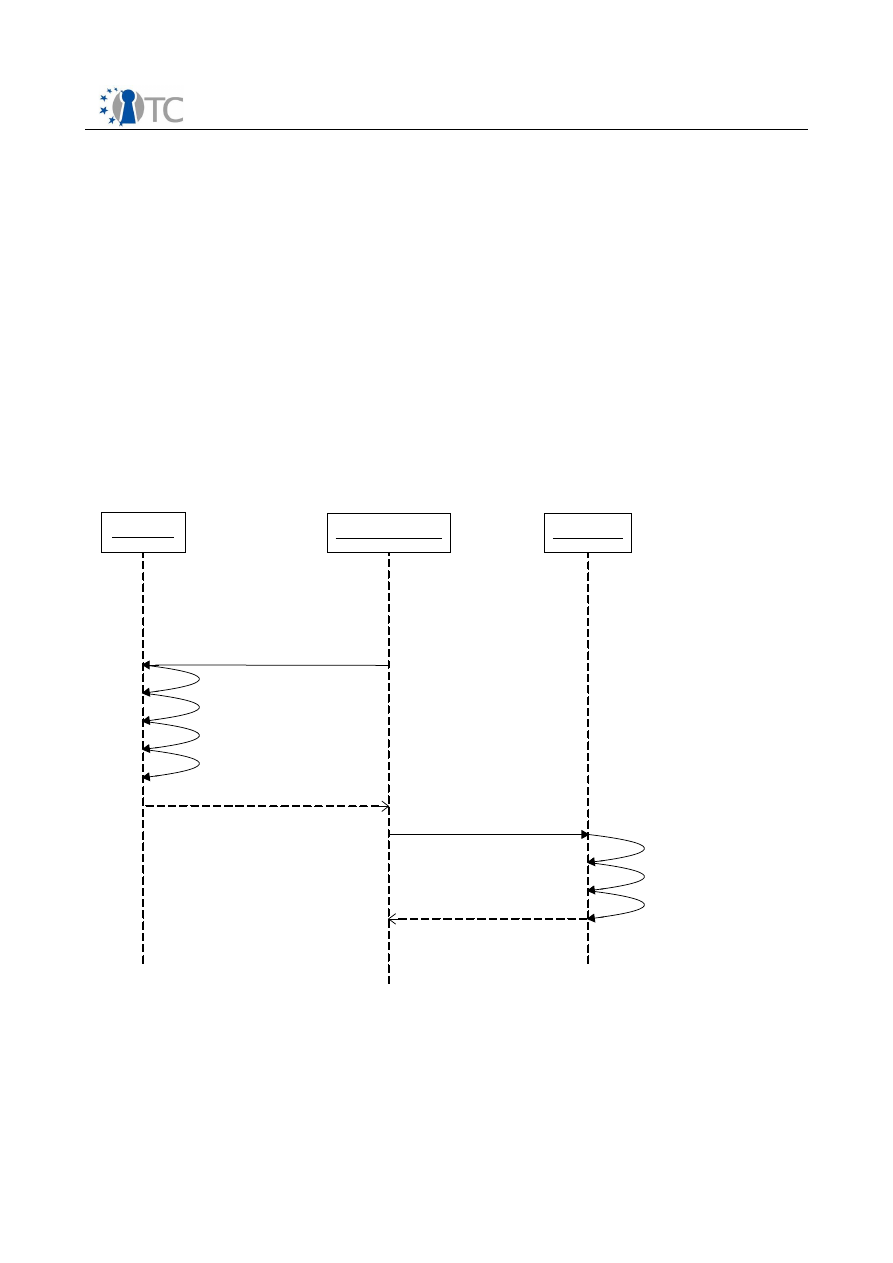
MFA Intermediate System Specification
PUBLIC | 1.00
4 Functionality
4.1 Actions
There are three actions that can be performed on the client:
1.
Platform registration with the remote server.
An existing user with
administrative rights can register the platform authentication information:
Platform AIK and platform Configuration Registers (PCRs)
.
Platform AIK is created inside the local TPM, AIK certificate request is built and
sent to the Open_TC Privacy CA. PCRs are extended during the bootstrap with
the integrity measurements of client computer software. Retrieved TPM
Platform Configuration Registers (PCRs) values and Platform AIK as Combined
Platform Registration Information (COREG) are sent to the server. The server
receives the COREG and uses it to create the Platform Identity – data, necessary
for authentication.
2.
User registration with remote server.
The possibility of a new user
registration relies solely on the existing infrastructure. the application does not
intend to interfere in any way the security practices existing in the
infrastructure.
3.
Logon to the remote server.
A client can logon to the remote server. This
Open_TC Deliverable 6e.3
6/16
Figure 2: Platform registration
MFA Client
MFA_Server
Registration request
Retrive PCRs
Hold the copy of PUBAIK
Create AIK (PUBAIK; PRIVAIK)
Hold the copy of SCERT
Hold the copy of PID
Registration scripts
COREG (PID, PUBAIK, PCRs)
Registration request with COREG
Hold the copy of PCRs
Registration succeeded
Generate Platform ID (PID)

MFA Intermediate System Specification
PUBLIC | 1.00
basically relies solely on the existing authentication infrastructure. In case the
remote server logon system supports the MFA extension, a client platform
authentication will be launched.
There are five actions that can be performed on the remote server:
1.
Register platform and store platform information
. The server supports the
platform registration. This procedure involves registering Platform AIK
certificate: the server saves the COREG in Master Repository.
2.
Platform authentication
. The server supports the platform authentication:
the server logon system launches the platform authentication by calling a
certain API function.
MFA server application retrieves the user policy and check it. After a successful
policy checking, the server establishes secure communication channel with a
remote MFA client using Secure protocol (OpenSSL library).
MFA server generates anti-reply challenge (CHALLENGE) and requests from MFA
Client the PCRs signed using the AIK key.
MFA client receives CHALLENGE and retrieves the TPM Platform Configuration
Registers (PCRs) values and the Platform AIK, sets up the Combined
Authentication Information (COAUTH):- Platform ID (PID), CHALLENGE - Platform
TPM PCRs.
COAUTH is signed with the Platform AIK to ensure the information integrity.
This Combined Authentication Information (COAUTH) is being send to the remote
server for authentication.
MFA server receives COAUTH and proceeds with the platform authentication. It
retrieves stored the platform information by PID, it verifies the signature and
involves the verification of the Platform TPM PCRs.
In this scenario network calls are synchronous. An established SSL channel is used as
binary stream.
Open_TC Deliverable 6e.3
7/16
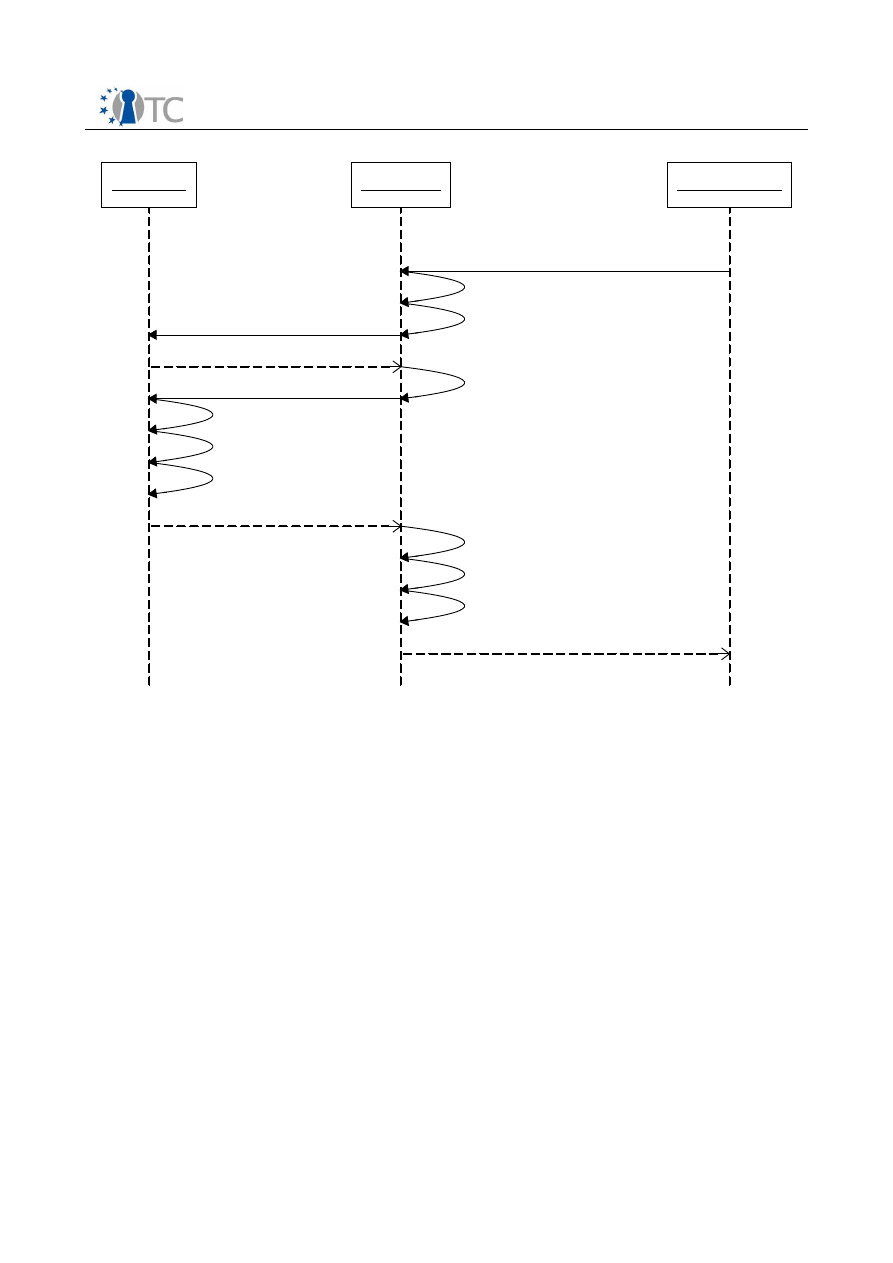
MFA Intermediate System Specification
PUBLIC | 1.00
3.
Authenticate user.
The server can verify user credentials. This basically relies
on the existing authentication infrastructure.
4.
Edit user/platform policy for multifactor access.
The system administrator
can change the user policies on the server to determine the required credentials
in order to logon to the server.
5.
Enforce policy for server access.
The server can verify the user credentials
against a defined policy set and reject the logon if multifactor authentication
fails.
4.2 Policies
The policy determines what type authentication is required to access the remote
service. The following policies will be defined:
●
The platform authentication is required (optional if policy is not set).
●
The list of platforms the user is allowed to login from (the user can use any
registered platform if this policy is not set).
4.3 Data structure organization example
Open_TC Deliverable 6e.3
8/16
Figure 3: Platform authentication
MFA_Client
MFA_Server
Unlock AIK with PCRs
Compute Response
Verify signature
PAM Framework
Check user policy (UserName)
Authenticate (ClientHostName, UserName)
Start SSL session
OK
Generate challenge
CHALLENGE
COAUTH (PID, PCRs, Signature )
Verify PCRs
Create SSL channel (ClientHostName)
Authentication succeeded
Retrive Platform ID (PID)
Verify PID
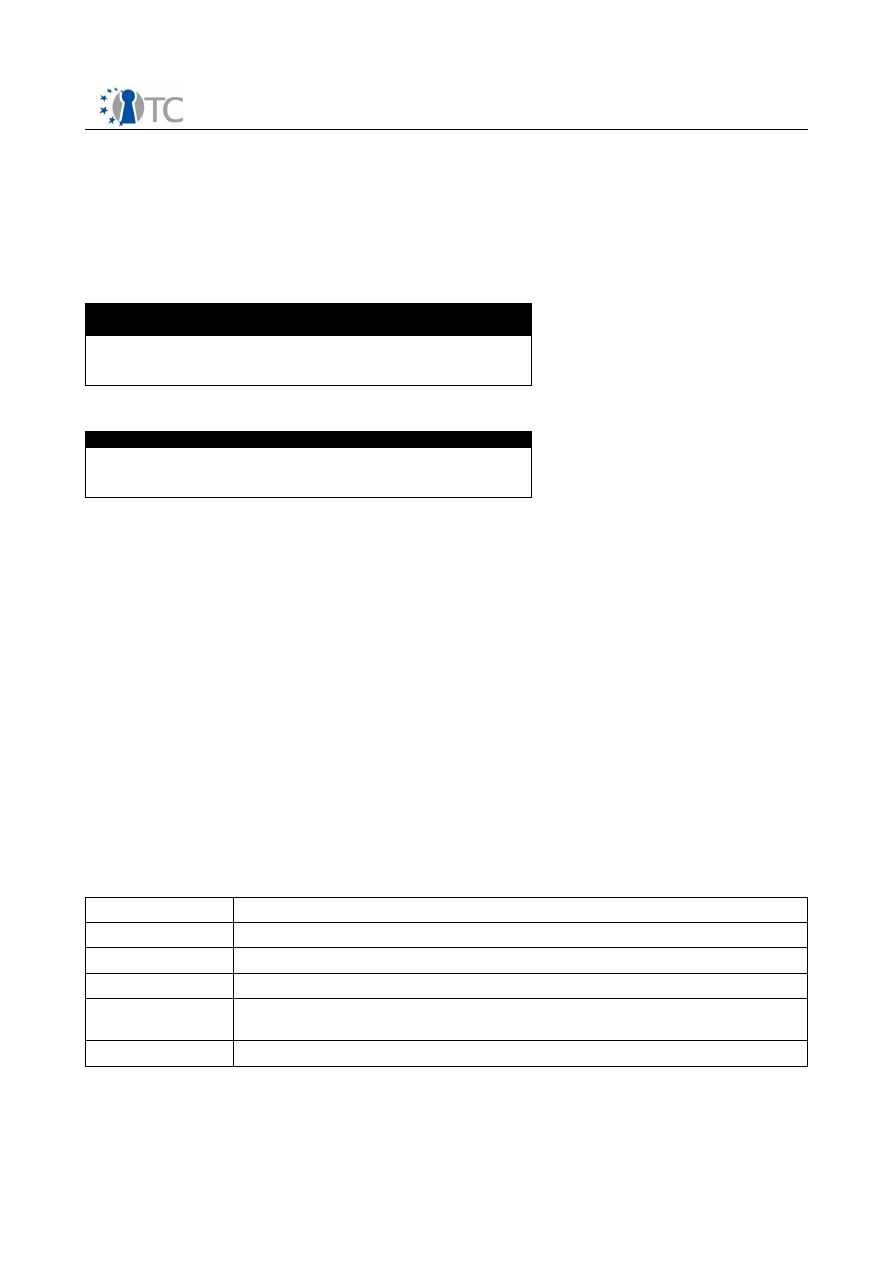
MFA Intermediate System Specification
PUBLIC | 1.00
All data can be expressed as two tables. The first one is the “Registered Platforms”
table. The second is a “Users Policies” table. “Registered Platforms” table consist of
three columns: “Platform ID (PID)”; “PCRs”; “Public AIK”. “Platform ID (PID)” is the
Primary Key (PK) of this table. “Users Policies” table also consists of three columns:
“User Name”; “Policy”; “Platform IDs set” where “User Name” column is the Primary
Key (PK) of this table.
“Registered Platforms” table example:
Platform ID
(PID)
PCRs
Certificate
(Public AIK)
123987
binary string binary string
321789
binary string binary string
456654
binary string binary string
“Users Policies” table example:
User Name
Policy
Platform IDs set
Jack
exclude
NULL
Tom
include
321789; 456654
Bill
include
NULL
In this example Jack can use any client computer to login to the server. The TPM
authentication will not be performed. Tom can use only two computers with a
registered TPM to login to the server. Bill can use any computer with a registered TPM.
5 Preliminary MFA API
5.1 Data Types
This section describes the basic data types defined by this API.
Pointer Size:
Pointer size becomes 32 bits on 32-bit systems and 64 bits with 64-bit system.
Basic Types:
There are some new types for 64-bit systems that were derived from the basic
C_language integer and long types, so they work in existing code. These are the
expected values and definitions.
Type
Definition
UINT16
Unsigned INT16
UINT32
Unsigned INT32
BYTE
Unsigned character
MFA_UNICODE
MFA_UNICODE character. MFA_UNICODE characters are to be
treated as an array of 16 bits.
MFA_PVOID
void Pointer (32 or 64 bit depending on architecture)
Derived Types:
Open_TC Deliverable 6e.3
9/16

MFA Intermediate System Specification
PUBLIC | 1.00
Type
Definition
Usage
MFA_HCONTEXT
UINT32
Context object handle
MFA_FLAG
UINT32
Object attributes
MFA_RESULT
UINT32
result of a MFA interface command
Common return code defines:
Type
Definition
MFA_SUCCESS
Success
MFA_E_FAIL
Non-specific failure
MFA_E_BAD_ARGUMENT
One or more parameter is bad.
MFA_E_INTERNAL_ERROR
An internal SW error has been detected.
MFA_E_NOTIMPL
Not implemented
MFA_E_CANCELED
The action was canceled
MFA_E_TIMEOUT
The operation has timed out
MFA_E_OUTOFMEMORY
Ran out of memory
5.2 Structures
This section describes the structures defined by this API.
5.2.1 MFA_VERSION
This structure allows the MFA to communicate between various versions of client and
server application components.
Definition:
typedef struct tdMFA_VERSION
{
BYTE bMajor;
BYTE bMinor;
} MFA_VERSION;
Parameters:
bMajor
This SHALL be the major version indicator for this implementation of the MFA
specification. For version 1 this must be 0x01
bMinor
This SHALL be the minor version indicator for this implementation of the MFA
specification. For version 1.0 this must be 0x00, for version 1.1, this must be
0x01.
5.2.1 MFA_CONTEXT_INFO
This structure provides information about context status. It used with
mfa_S_Context_GetStatus and mfa_C_Context_GetStatus interface functions.
Definition:
Open_TC Deliverable 6e.3
10/16

MFA Intermediate System Specification
PUBLIC | 1.00
typedef struct tdMFA_CONTEXT_INFO
{
MFA_VERSION versionInfo;
MFA_RESULT lastError;
} MFA_CONTEXT_INFO;
Parameters:
versionInfo
Version data set by MFA interface function
lastError
Last occurred error in current context
5.3 Interface definition
The syntax used in describing the MFA application is based on the common procedural
language constructs. Data types are described in terms of ANSI C.
The MFA allocates memory for out parameters and provides a function to free the
memory previously allocated by the MFA on a context object base. The calling
application MUST free memory allocated by the MFA. The caller of the MFA interface
functions is responsible for calling mfa_S_Context_FreeMemory or
mfa_C_Context_FreeMemory for each call that produced allocation of memory.
The mfa_Context class represents a context of a connection to the server side MFA
application core.
5.3.1 mfa_Context_Create
This method returns a handle to a new server side context object. The context handle
is used in various functions to assign resources to it.
Definition:
MFA_RESULT mfa_Context_Create
(
MFA_HCONTEXT* phContext // out
);
Parameters:
phContext
Pointer to a variable that receives the handle to the created context object.
Return Values:
MFA_SUCCESS
MFA_E_BAD_ARGUMENT
5.3.2 mfa_Context_Close
This method destroys a server side context and releases all assigned resources.
Definition:
MFA_RESULT mfa_Context_Close
(
MFA_HCONTEXT hContext // in
);
Open_TC Deliverable 6e.3
11/16

MFA Intermediate System Specification
PUBLIC | 1.00
Parameters:
hContext
Handle of the context object which is to be closed.
Return Values:
MFA_SUCCESS
MFA_E_INVALID_HANDLE
MFA_E_INTERNAL_ERROR
5.3.3 mfa_Context_GetStatus
This method provides operation status in specified context.
Definition:
MFA_RESULT mfa_Context_GetStatus
(
MFA_HCONTEXT hContext, // in
MFA_CONTEXT_INFO** ppStatus // out
);
Parameters:
hContext
Handle of the context object.
ppStatus
Pointer to a variable that receives a pointer to the context information structure.
When the use of the pointer ends, free the returned buffer by calling the
mfa_S_Context_FreeMemory function.
Return Values:
MFA_SUCCESS
MFA_E_BAD_ARGUMENT
MFA_E_INVALID_HANDLE
MFA_E_INTERNAL_ERROR
5.3.4 mfa_Context_FreeMemory
This method frees memory allocated by MFA application on a server side context base.
Definition:
MFA_RESULT mfa_Context_FreeMemory
(
MFA_HCONTEXT hContext, // in
BYTE* rgbMemory // in
);
Parameters:
hContext
Handle of the context object.
rgbMemory
Pointer to the memory block to be deallocated.
Return Values:
MFA_SUCCESS
MFA_E_INVALID_HANDLE
Open_TC Deliverable 6e.3
12/16

MFA Intermediate System Specification
PUBLIC | 1.00
MFA_E_INTERNAL_ERROR
MFA_E_INVALID_RESOURCE
5.3.5 mfa_S_RegisterPlatform
This method store platform registration information received from remote client as
Platform Identity for future use in authentication process.
Definition:
MFA_RESULT mfa_S_RegisterPlatform
(
MFA_HCONTEXT hContext, // in
BYTE* pPltmInfoData, // in
UINT32 pltmInfoSize // out
);
Parameters:
hContext
Handle of the context object.
pPltmInfoData
Pointer to a buffer containing the platform registration information (COREG).
pltmInfoSize
Size of the information pointed to by the
pPltmInfoData
parameter, in bytes.
5.3.6 mfa_S_Authenticate
This method provides remote platform authentication.
Definition:
MFA_RESULT mfa_S_Authenticate
(
MFA_HCONTEXT hContext, // in
MFA_UNICODE* userName, // in
MFA_UNICODE* platformHostName // in
);
Parameters:
hContext
Handle of the context object which is to be closed.
userName
Pointer to the MFA_UNICODE string contain name of the user
platformHostName
Pointer to the MFA_UNICODE string contain name of the client host platform
5.3.7 mfa_S_SetAccessPolicy
This method sets user access policy. That data is used during authentication process.
Definition:
MFA_RESULT mfa_S_SetAccessPolicy
(
MFA_HCONTEXT hContext, // in
BYTE* pPolInfoData, // in
UINT32 pPolInfoSize // in
);
Open_TC Deliverable 6e.3
13/16

MFA Intermediate System Specification
PUBLIC | 1.00
Parameters:
hContext
Handle of the context object.
pPolInfoData
Pointer to a buffer containing the user policy information.
pltmInfoSize
Size of the information pointed to by the
pPolInfoData
parameter, in bytes.
5.3.8 mfa_S_GetAccessPolicy
This method gets user access policy. That data is used during authentication process.
Definition:
MFA_RESULT mfa_S_GetAccessPolicy
(
MFA_HCONTEXT hContext, // in
BYTE* pPolInfoData, // out
UINT32* pPolInfoSize // in/out
);
Parameters:
hContext
Handle of the context object.
pPolInfoData
Pointer to a buffer with user policy information.
pltmInfoSize
Pointer to size of the information pointed to by the
pPolInfoData
parameter, in
bytes.
5.3.9 mfa_Platform_Initialize
This methods takes TPM ownership, create Platform AIK.
Definition:
MFA_RESULT mfa_Initialize
(
);
Parameters:
Return Values:
MFA_SUCCESS
5.3.10 mfa_C_GetPlaformData
This method retrieves the platform information.
Definition:
MFA_RESULT mfa_C_GetPlatformData
(
MFA_HCONTEXT hContext, // in
BYTE** ppPltmInfoData, // out
UINT32* pPltmInfoSize // out
);
Open_TC Deliverable 6e.3
14/16
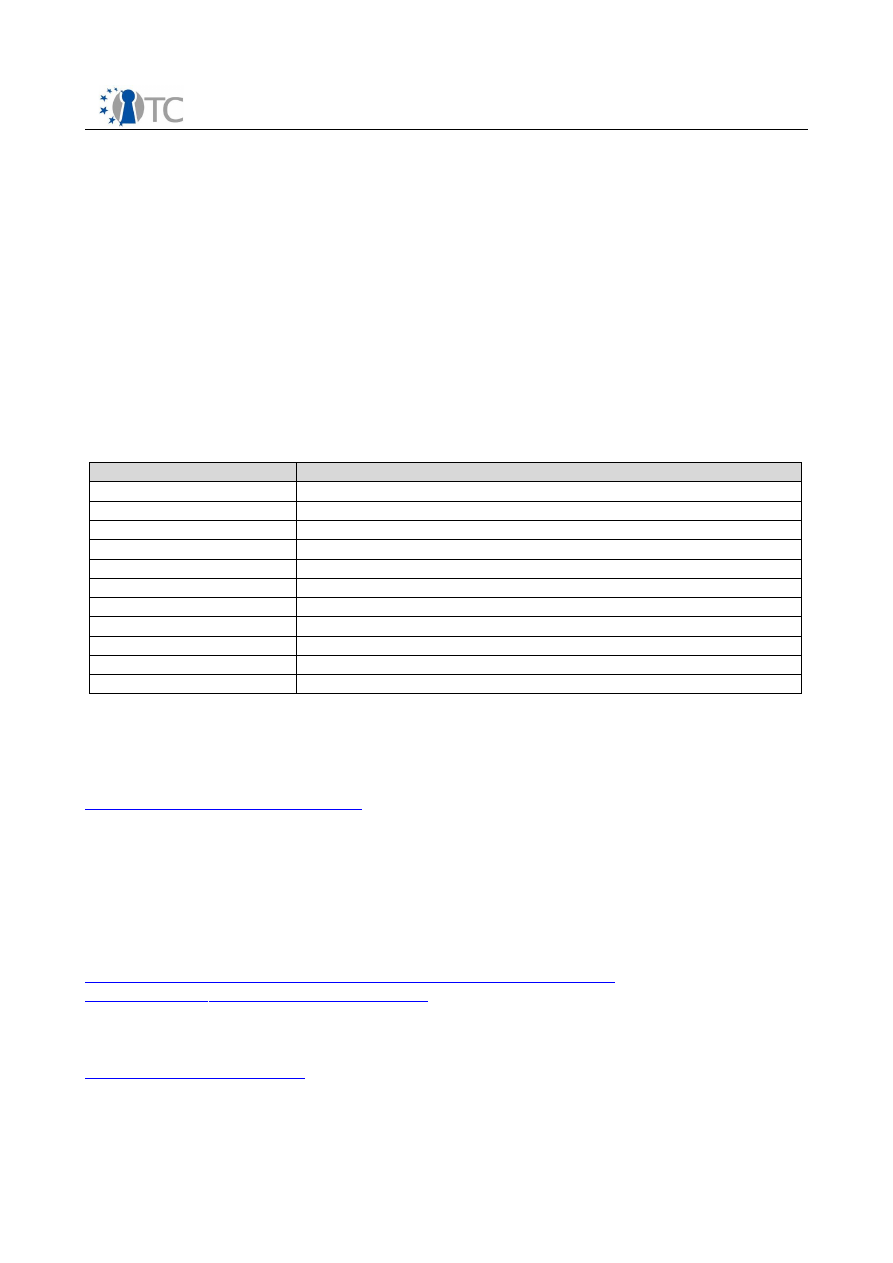
MFA Intermediate System Specification
PUBLIC | 1.00
Parameters:
hContext
Handle of the context object.
ppPltmInfoData
Pointer to a variable that receives a pointer to the buffer which contain the
platform information. When the use of the pointer ends, free the returned buffer
by calling the mfa_S_Context_FreeMemory function.
pPltmInfoSize
Pointer to a variable that receives the size of the buffer pointed to the
ppPltmInfoData
parameter, in bytes. When the function returns, the UINT32
value contains the number of bytes stored in the buffer.
6 List of abbreviations
Listing of term definitions and abbreviations used in this document (IT expressions and
terms from the application domain).
Abbreviation
Explanation
AIK
Attestation Identity Key
API
Application Programming Interface
MFA
MultiFactor Authentication
OS
Operating System
PCR
Platform Configuration Register
SSL
Secure Sockets Layer
TC
Trusted Computing
TCB
Trusted Computing Base
TCG
Trusted Computing Group
TPM
Trusted Platform Module
TSS
Trusted Software Stack
7 Referenced Documents
/1/ TCG Specification, Architecture Overview.
http://www.trustedcomputing.org
April 28, 2004,
Version 1.2
/2/ TCG Software Stack (TSS) Specification
January 6, 2006,
Version 1.2
/3/ PAM
http://www.kernel.org/pub/linux/libs/pam/Linux-PAM-html/Linux-
PAM_ADG.html
http://msdn.microsoft.com
Version 0.99.6.0, 5. August 2006.
/4/ Secure Coding Guidelines
http://msdn.microsoft.com
2004
/5/ Improving Web Application Security: Threats and Countermeasures
Open_TC Deliverable 6e.3
15/16

MFA Intermediate System Specification
PUBLIC | 1.00
http://msdn.microsoft.com
/6/ Writing Secure Code, Second Edition, by Michael Howard, David C. LeBlanc
/7/ OpenSSL Toolkit
www.openssl.org/
Open_TC Deliverable 6e.3
16/16
Document Outline
- otcW06_ADDENDUM_to_D6.1_and_D6.2_almost-final.pdf
- otcW06-D6a1-v02-Preliminary_DRM_system_specification.pdf
- otcW06-D6e1-v01-MFA_Requirements_And_Specification.pdf
- otcW06-D6e3-v01-MFA_Intermediate_System_Specification.pdf




















































































